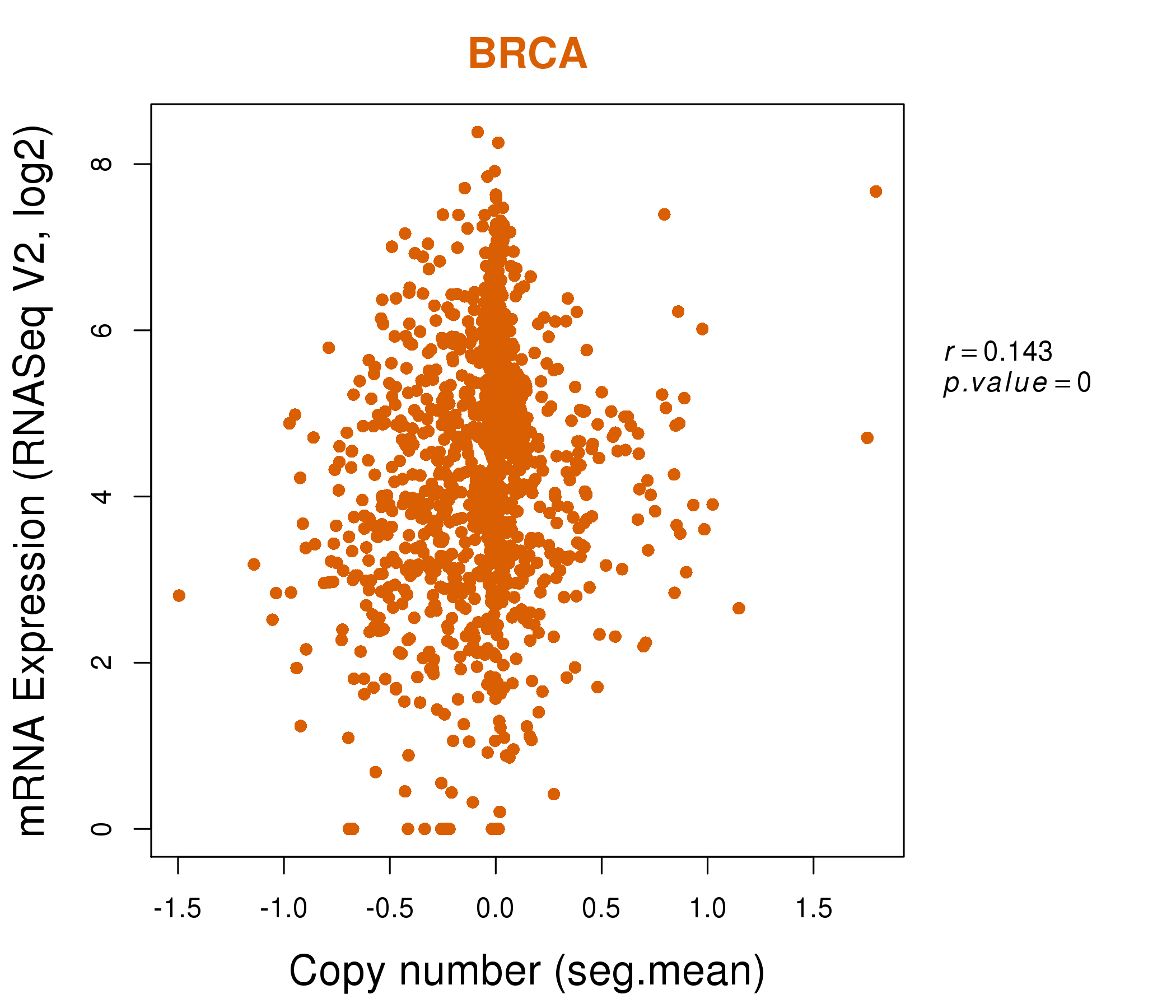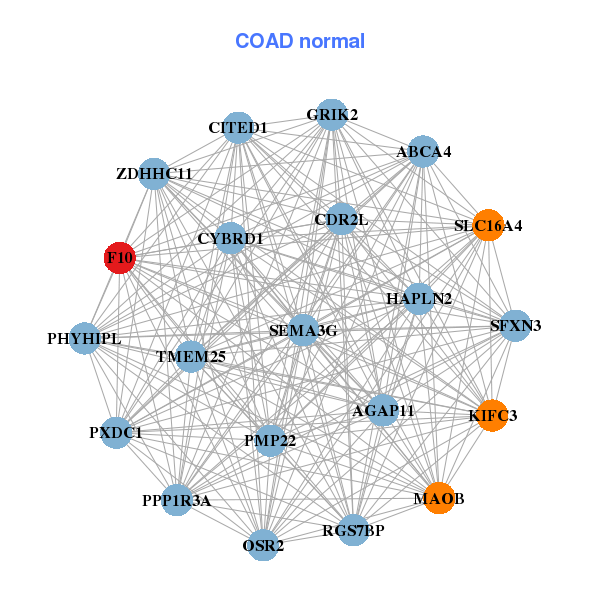|
||||||||||||||||||||||||||||||||||||||||||||||||||||||||||||||||||||||||||||||||||||||||||||||||||||||||||||||||||||||||||||||||||||||||||||||||||||||||||||||||||||||||||||||||||||||||||||||||||||||||||||||||||||||||||||||||||||||||||||||||||||||||||||||||||||||||||||||||||||||||||||||||||||||||||||||||||||||||||||||||||||||||||||||||||||||||||||||||||||||||||||||||||||||||||||||||||||||||||||||||||||||||||||||||||||||||||||||||||||||||||||||||||||||||||||||||||||||||||||||||||||||||||||||||||||||||||||||||||||||||||||||||||||||||||||||||||||||||
| |
| Phenotypic Information (metabolism pathway, cancer, disease, phenome) |
| |
| |
| Gene-Gene Network Information: Co-Expression Network, Interacting Genes & KEGG |
| |
|
| Gene Summary for F10 |
| Basic gene info. | Gene symbol | F10 |
| Gene name | coagulation factor X | |
| Synonyms | FX|FXA | |
| Cytomap | UCSC genome browser: 13q34 | |
| Genomic location | chr13 :113777112-113803843 | |
| Type of gene | protein-coding | |
| RefGenes | NM_000504.3, | |
| Ensembl id | ENSG00000126218 | |
| Description | Stuart-Prower factorfactor Xaprothrombinase | |
| Modification date | 20141207 | |
| dbXrefs | MIM : 613872 | |
| HGNC : HGNC | ||
| Ensembl : ENSG00000126218 | ||
| HPRD : 01966 | ||
| Vega : OTTHUMG00000017374 | ||
| Protein | UniProt: P00742 go to UniProt's Cross Reference DB Table | |
| Expression | CleanEX: HS_F10 | |
| BioGPS: 2159 | ||
| Gene Expression Atlas: ENSG00000126218 | ||
| The Human Protein Atlas: ENSG00000126218 | ||
| Pathway | NCI Pathway Interaction Database: F10 | |
| KEGG: F10 | ||
| REACTOME: F10 | ||
| ConsensusPathDB | ||
| Pathway Commons: F10 | ||
| Metabolism | MetaCyc: F10 | |
| HUMANCyc: F10 | ||
| Regulation | Ensembl's Regulation: ENSG00000126218 | |
| miRBase: chr13 :113,777,112-113,803,843 | ||
| TargetScan: NM_000504 | ||
| cisRED: ENSG00000126218 | ||
| Context | iHOP: F10 | |
| cancer metabolism search in PubMed: F10 | ||
| UCL Cancer Institute: F10 | ||
| Assigned class in ccmGDB | B - This gene belongs to cancer gene. | |
| Top |
| Phenotypic Information for F10(metabolism pathway, cancer, disease, phenome) |
| Cancer | CGAP: F10 |
| Familial Cancer Database: F10 | |
| * This gene is included in those cancer gene databases. |
|
|
|
|
|
| . | ||||||||||||||||||||||||||||||||||||||||||||||||||||||||||||||||||||||||||||||||||||||||||||||||||||||||||||||||||||||||||||||||||||||||||||||||||||||||||||||||||||||||||||||||||||||||||||||||||||||||||||||||||||||||||||||||||||||||||||||||||||||||||||||||||||||||||||||||||||||||||||||||||||||||||||||||||||||||||||||||||||||||||||||||||||||||||||||||||||||||||||||||||||||||||||||||||||||||||||||||||||||||||||||||||||||||||||||||||||||||||||||||||||||||||||||||||||||||||||||||||||||||||||||||||||||||||||||||||||||||||||||||||||||||||||||||||
Oncogene 1 | Significant driver gene in | |||||||||||||||||||||||||||||||||||||||||||||||||||||||||||||||||||||||||||||||||||||||||||||||||||||||||||||||||||||||||||||||||||||||||||||||||||||||||||||||||||||||||||||||||||||||||||||||||||||||||||||||||||||||||||||||||||||||||||||||||||||||||||||||||||||||||||||||||||||||||||||||||||||||||||||||||||||||||||||||||||||||||||||||||||||||||||||||||||||||||||||||||||||||||||||||||||||||||||||||||||||||||||||||||||||||||||||||||||||||||||||||||||||||||||||||||||||||||||||||||||||||||||||||||||||||||||||||||||||||||||||||||||||||||||||||||||||||
| cf) number; DB name 1 Oncogene; http://nar.oxfordjournals.org/content/35/suppl_1/D721.long, 2 Tumor Suppressor gene; https://bioinfo.uth.edu/TSGene/, 3 Cancer Gene Census; http://www.nature.com/nrc/journal/v4/n3/abs/nrc1299.html, 4 CancerGenes; http://nar.oxfordjournals.org/content/35/suppl_1/D721.long, 5 Network of Cancer Gene; http://ncg.kcl.ac.uk/index.php, 1Therapeutic Vulnerabilities in Cancer; http://cbio.mskcc.org/cancergenomics/statius/ |
| REACTOME_METABOLISM_OF_PROTEINS | |
| OMIM | 227600; phenotype. 613872; gene. |
| Orphanet | 328; Congenital factor X deficiency. |
| Disease | KEGG Disease: F10 |
| MedGen: F10 (Human Medical Genetics with Condition) | |
| ClinVar: F10 | |
| Phenotype | MGI: F10 (International Mouse Phenotyping Consortium) |
| PhenomicDB: F10 | |
| Mutations for F10 |
| * Under tables are showing count per each tissue to give us broad intuition about tissue specific mutation patterns.You can go to the detailed page for each mutation database's web site. |
| - Statistics for Tissue and Mutation type | Top |
 |
| - For Inter-chromosomal Variations |
| There's no inter-chromosomal structural variation. |
| - For Intra-chromosomal Variations |
| * Intra-chromosomal variantions includes 'intrachromosomal amplicon to amplicon', 'intrachromosomal amplicon to non-amplified dna', 'intrachromosomal deletion', 'intrachromosomal fold-back inversion', 'intrachromosomal inversion', 'intrachromosomal tandem duplication', 'Intrachromosomal unknown type', 'intrachromosomal with inverted orientation', 'intrachromosomal with non-inverted orientation'. |
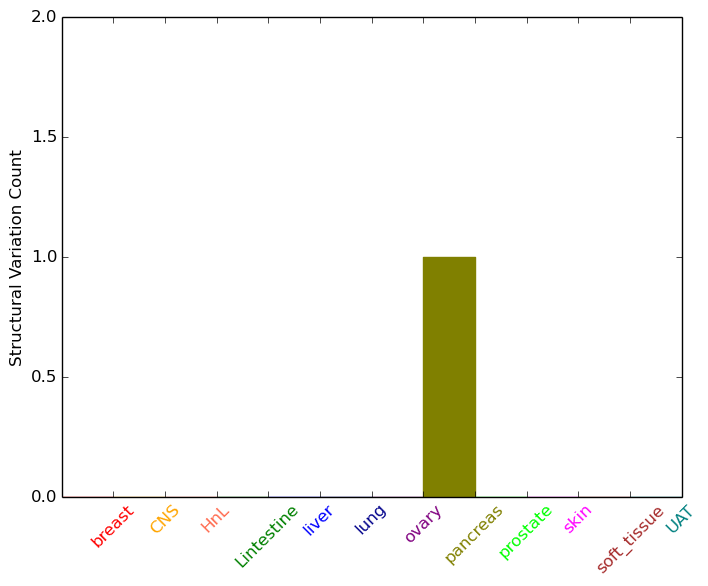 |
| Sample | Symbol_a | Chr_a | Start_a | End_a | Symbol_b | Chr_b | Start_b | End_b |
| pancreas | F10 | chr13 | 113790941 | 113790961 | F10 | chr13 | 113791254 | 113791274 |
| cf) Tissue number; Tissue name (1;Breast, 2;Central_nervous_system, 3;Haematopoietic_and_lymphoid_tissue, 4;Large_intestine, 5;Liver, 6;Lung, 7;Ovary, 8;Pancreas, 9;Prostate, 10;Skin, 11;Soft_tissue, 12;Upper_aerodigestive_tract) |
| * From mRNA Sanger sequences, Chitars2.0 arranged chimeric transcripts. This table shows F10 related fusion information. |
| ID | Head Gene | Tail Gene | Accession | Gene_a | qStart_a | qEnd_a | Chromosome_a | tStart_a | tEnd_a | Gene_a | qStart_a | qEnd_a | Chromosome_a | tStart_a | tEnd_a |
| N93529 | EEF2 | 29 | 152 | 19 | 3976054 | 3976177 | F10 | 148 | 247 | 13 | 113803335 | 113803434 | |
| Top |
| Mutation type/ Tissue ID | brca | cns | cerv | endome | haematopo | kidn | Lintest | liver | lung | ns | ovary | pancre | prost | skin | stoma | thyro | urina | |||
| Total # sample | 1 | 2 | 2 | |||||||||||||||||
| GAIN (# sample) | 1 | 2 | ||||||||||||||||||
| LOSS (# sample) | 2 |
| cf) Tissue ID; Tissue type (1; Breast, 2; Central_nervous_system, 3; Cervix, 4; Endometrium, 5; Haematopoietic_and_lymphoid_tissue, 6; Kidney, 7; Large_intestine, 8; Liver, 9; Lung, 10; NS, 11; Ovary, 12; Pancreas, 13; Prostate, 14; Skin, 15; Stomach, 16; Thyroid, 17; Urinary_tract) |
| Top |
|
 |
| Top |
| Stat. for Non-Synonymous SNVs (# total SNVs=47) | (# total SNVs=19) |
 | 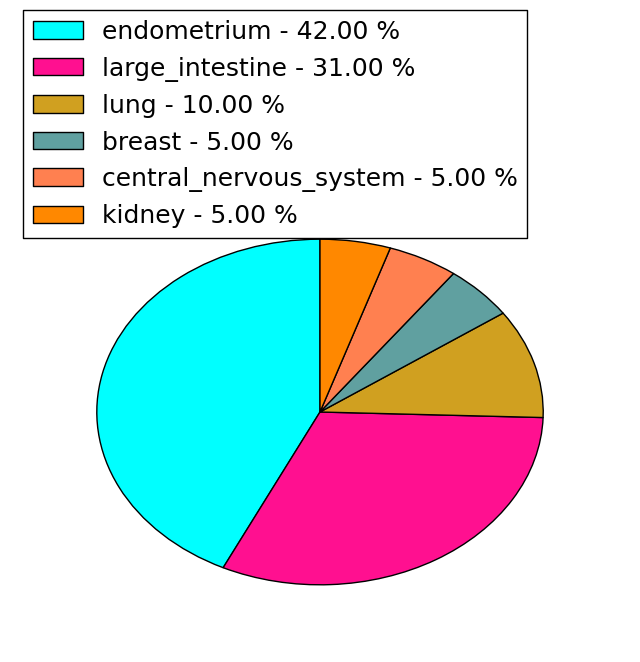 |
(# total SNVs=0) | (# total SNVs=0) |
| Top |
| * When you move the cursor on each content, you can see more deailed mutation information on the Tooltip. Those are primary_site,primary_histology,mutation(aa),pubmedID. |
| GRCh37 position | Mutation(aa) | Unique sampleID count |
| chr13:113803380-113803380 | p.A339V | 4 |
| chr13:113793763-113793763 | p.E117K | 4 |
| chr13:113798367-113798367 | p.I235I | 3 |
| chr13:113803660-113803660 | p.F432F | 3 |
| chr13:113793762-113793762 | p.F116F | 3 |
| chr13:113798349-113798349 | p.D229D | 2 |
| chr13:113783888-113783888 | p.E65K | 2 |
| chr13:113803327-113803327 | p.F321F | 2 |
| chr13:113795330-113795330 | p.T156T | 2 |
| chr13:113801772-113801772 | p.H276R | 2 |
| Top |
|
 |
| Point Mutation/ Tissue ID | 1 | 2 | 3 | 4 | 5 | 6 | 7 | 8 | 9 | 10 | 11 | 12 | 13 | 14 | 15 | 16 | 17 | 18 | 19 | 20 |
| # sample | 1 | 8 | 2 | 4 | 1 | 6 | 5 | 2 | 15 | 8 | 1 | 13 | ||||||||
| # mutation | 1 | 8 | 2 | 4 | 1 | 6 | 5 | 2 | 14 | 8 | 1 | 17 | ||||||||
| nonsynonymous SNV | 4 | 1 | 3 | 1 | 5 | 3 | 1 | 7 | 5 | 1 | 10 | |||||||||
| synonymous SNV | 1 | 4 | 1 | 1 | 1 | 2 | 1 | 7 | 3 | 7 |
| cf) Tissue ID; Tissue type (1; BLCA[Bladder Urothelial Carcinoma], 2; BRCA[Breast invasive carcinoma], 3; CESC[Cervical squamous cell carcinoma and endocervical adenocarcinoma], 4; COAD[Colon adenocarcinoma], 5; GBM[Glioblastoma multiforme], 6; Glioma Low Grade, 7; HNSC[Head and Neck squamous cell carcinoma], 8; KICH[Kidney Chromophobe], 9; KIRC[Kidney renal clear cell carcinoma], 10; KIRP[Kidney renal papillary cell carcinoma], 11; LAML[Acute Myeloid Leukemia], 12; LUAD[Lung adenocarcinoma], 13; LUSC[Lung squamous cell carcinoma], 14; OV[Ovarian serous cystadenocarcinoma ], 15; PAAD[Pancreatic adenocarcinoma], 16; PRAD[Prostate adenocarcinoma], 17; SKCM[Skin Cutaneous Melanoma], 18:STAD[Stomach adenocarcinoma], 19:THCA[Thyroid carcinoma], 20:UCEC[Uterine Corpus Endometrial Carcinoma]) |
| Top |
| * We represented just top 10 SNVs. When you move the cursor on each content, you can see more deailed mutation information on the Tooltip. Those are primary_site, primary_histology, mutation(aa), pubmedID. |
| Genomic Position | Mutation(aa) | Unique sampleID count |
| chr13:113793763 | p.E117K | 4 |
| chr13:113793762 | p.E65K | 2 |
| chr13:113803660 | p.F432F | 2 |
| chr13:113803259 | p.F116F | 2 |
| chr13:113795330 | p.T156T | 2 |
| chr13:113783888 | p.G299S | 2 |
| chr13:113803537 | p.F321F | 1 |
| chr13:113795349 | p.P422P | 1 |
| chr13:113798391 | p.C62Y | 1 |
| chr13:113803786 | p.D216N | 1 |
| * Copy number data were extracted from TCGA using R package TCGA-Assembler. The URLs of all public data files on TCGA DCC data server were gathered on Jan-05-2015. Function ProcessCNAData in TCGA-Assembler package was used to obtain gene-level copy number value which is calculated as the average copy number of the genomic region of a gene. |
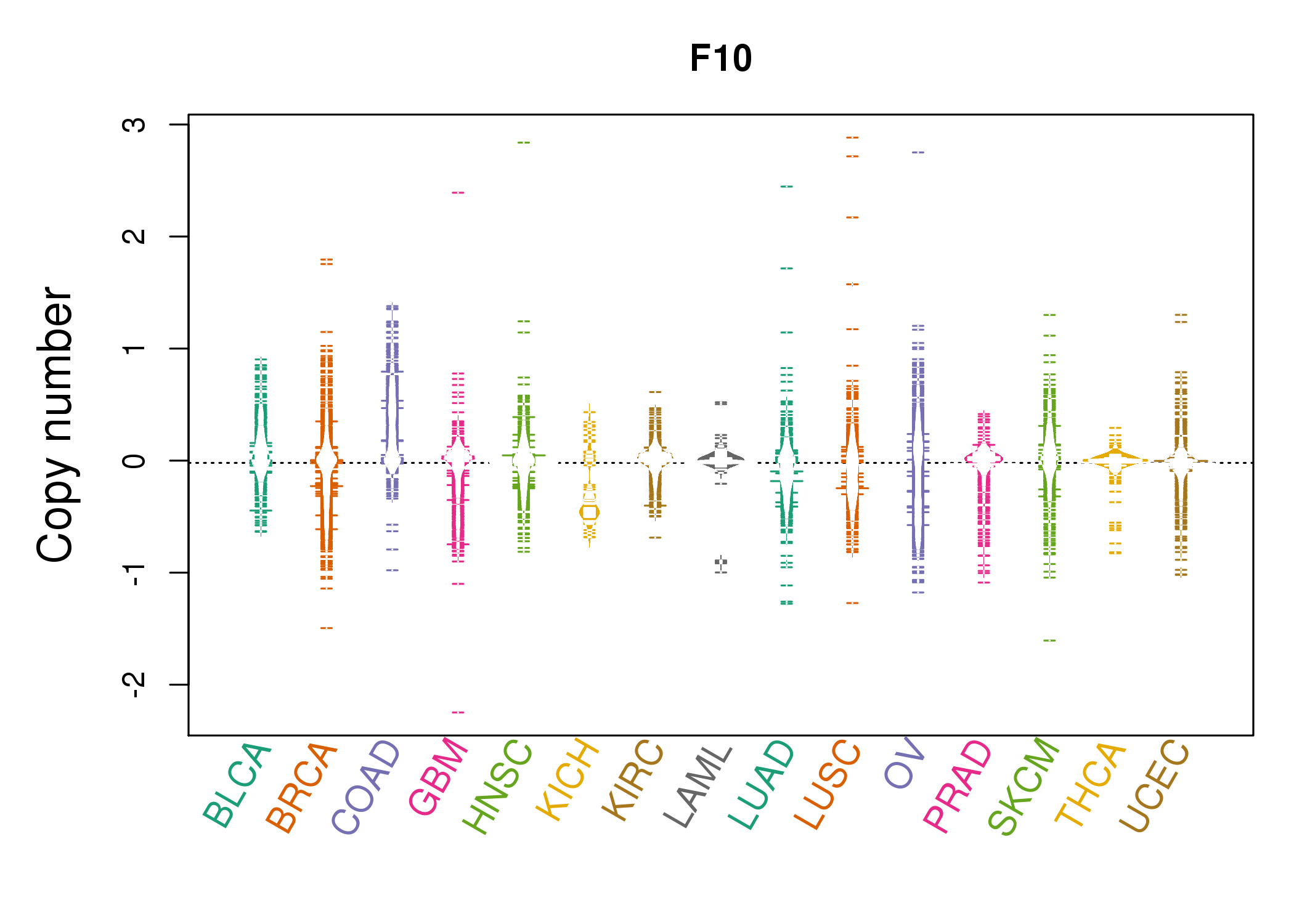 |
| cf) Tissue ID[Tissue type]: BLCA[Bladder Urothelial Carcinoma], BRCA[Breast invasive carcinoma], CESC[Cervical squamous cell carcinoma and endocervical adenocarcinoma], COAD[Colon adenocarcinoma], GBM[Glioblastoma multiforme], Glioma Low Grade, HNSC[Head and Neck squamous cell carcinoma], KICH[Kidney Chromophobe], KIRC[Kidney renal clear cell carcinoma], KIRP[Kidney renal papillary cell carcinoma], LAML[Acute Myeloid Leukemia], LUAD[Lung adenocarcinoma], LUSC[Lung squamous cell carcinoma], OV[Ovarian serous cystadenocarcinoma ], PAAD[Pancreatic adenocarcinoma], PRAD[Prostate adenocarcinoma], SKCM[Skin Cutaneous Melanoma], STAD[Stomach adenocarcinoma], THCA[Thyroid carcinoma], UCEC[Uterine Corpus Endometrial Carcinoma] |
| Top |
| Gene Expression for F10 |
| * CCLE gene expression data were extracted from CCLE_Expression_Entrez_2012-10-18.res: Gene-centric RMA-normalized mRNA expression data. |
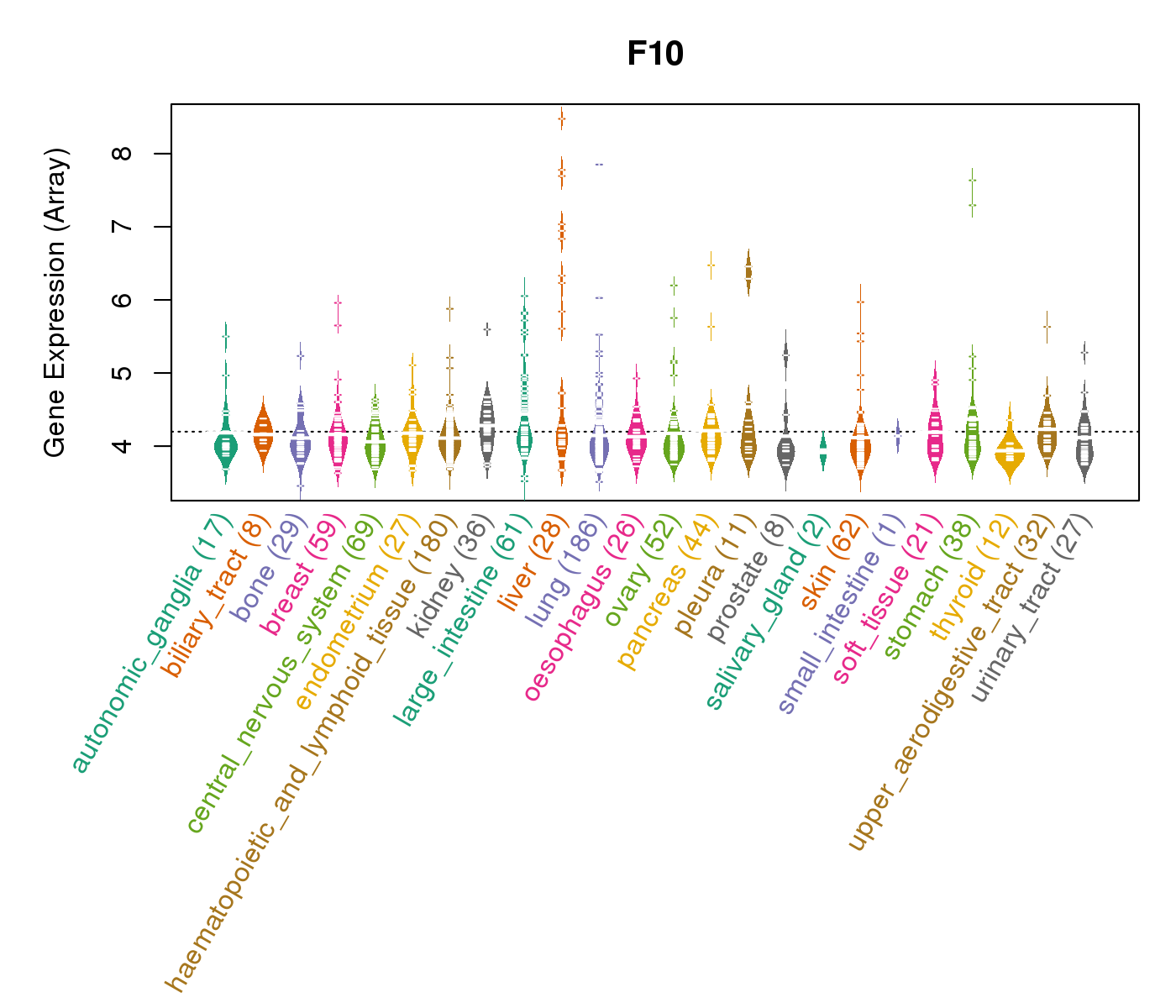 |
| * Normalized gene expression data of RNASeqV2 was extracted from TCGA using R package TCGA-Assembler. The URLs of all public data files on TCGA DCC data server were gathered at Jan-05-2015. Only eight cancer types have enough normal control samples for differential expression analysis. (t test, adjusted p<0.05 (using Benjamini-Hochberg FDR)) |
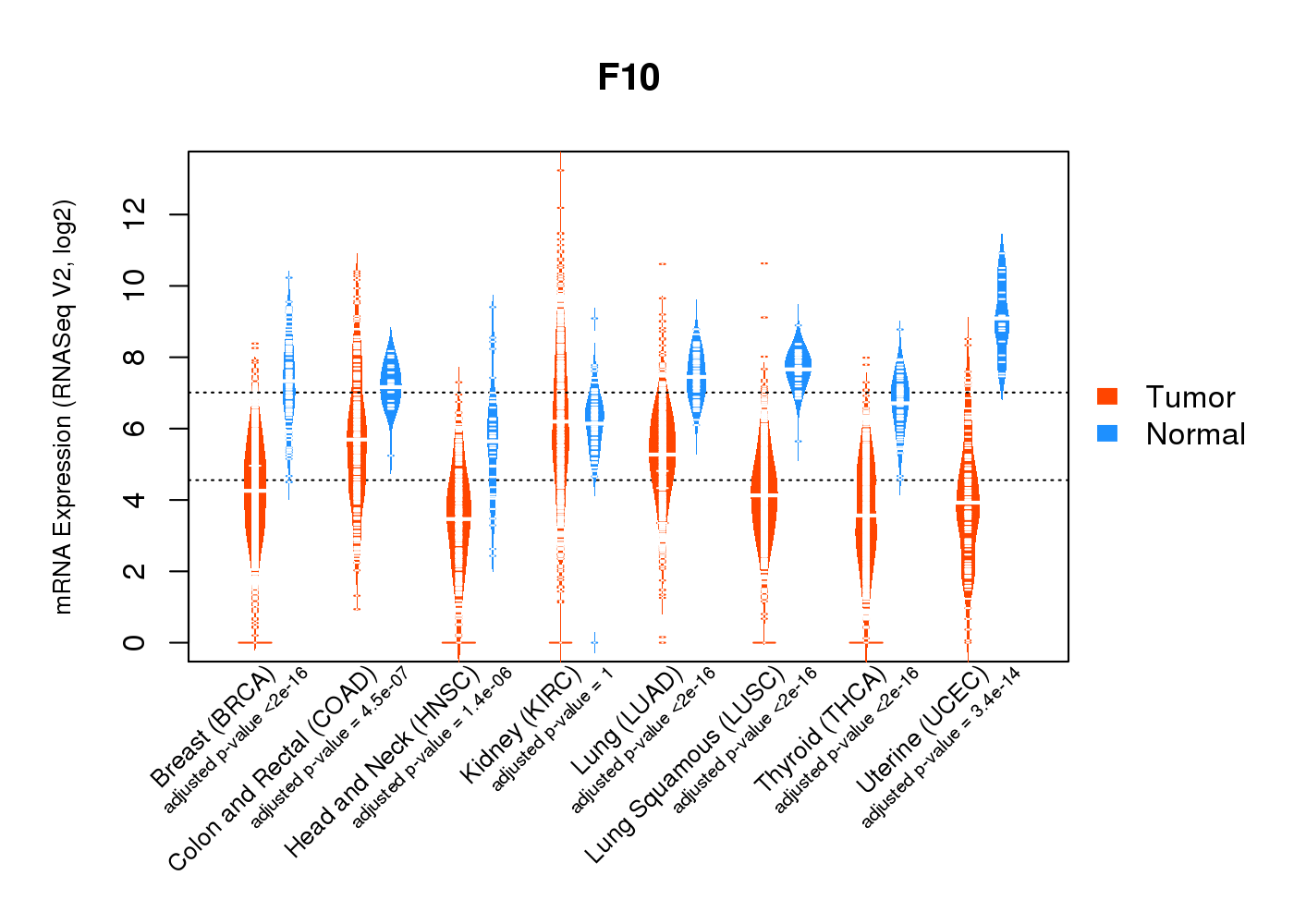 |
| Top |
| * This plots show the correlation between CNV and gene expression. |
: Open all plots for all cancer types
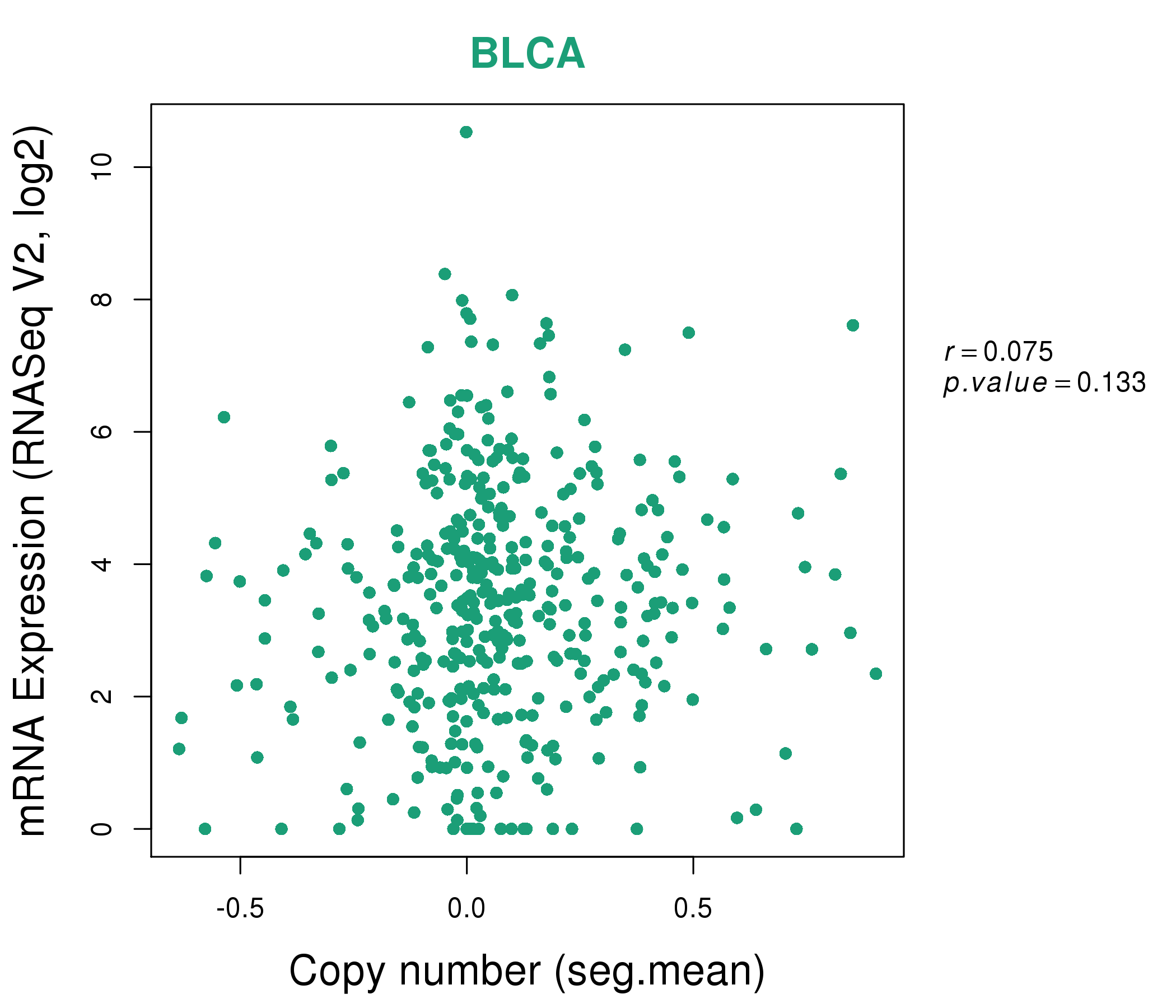 |
|
 |
|
| Top |
| Gene-Gene Network Information |
| * Co-Expression network figures were drawn using R package igraph. Only the top 20 genes with the highest correlations were shown. Red circle: input gene, orange circle: cell metabolism gene, sky circle: other gene |
: Open all plots for all cancer types
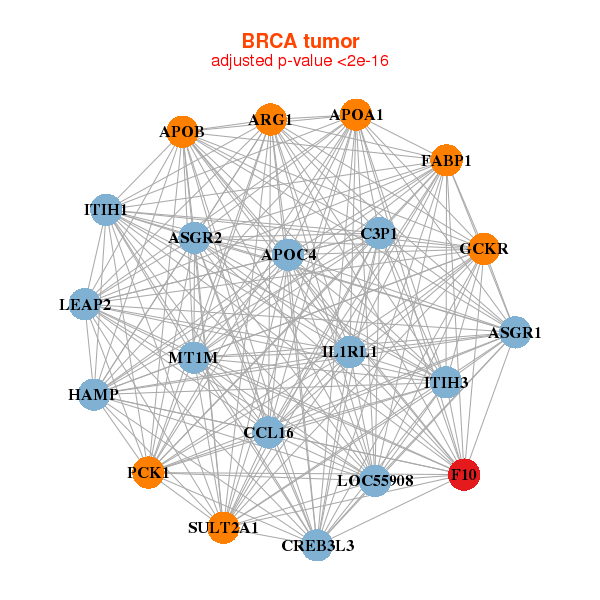 |
| ||||
| APOA1,APOB,APOC4,ARG1,ASGR1,ASGR2,C3P1, CCL16,CREB3L3,F10,FABP1,GCKR,HAMP,IL1RL1, ITIH1,ITIH3,LEAP2,LOC55908,MT1M,PCK1,SULT2A1 | C1QTNF2,EMX2,F10,FAM180B,FBLN1,FBLN2,FEZ1, GDF10,GRK5,HOXC5,LTBP4,MFAP4,MSX1,PHF19, PODN,PROCR,PTGIS,SCARA5,TNXB,WISP2,XPNPEP2 | ||||
 |
| ||||
| CAB39L,DACH1,HOGA1,ETNK2,F10,F7,FREM2, FZD10,LINC01512,MRPL57,N4BP2L1,N6AMT2,RAPGEF4,SAP18, SCT,SERPINF2,SLC5A6,TNFRSF19,TPTE2P3,WFDC10A,WIF1 | ABCA4,AGAP11,PXDC1,CDR2L,CITED1,CYBRD1,F10, GRIK2,HAPLN2,KIFC3,MAOB,OSR2,PHYHIPL,PMP22, PPP1R3A,RGS7BP,SEMA3G,SFXN3,SLC16A4,TMEM25,ZDHHC11 |
| * Co-Expression network figures were drawn using R package igraph. Only the top 20 genes with the highest correlations were shown. Red circle: input gene, orange circle: cell metabolism gene, sky circle: other gene |
: Open all plots for all cancer types
| Top |
: Open all interacting genes' information including KEGG pathway for all interacting genes from DAVID
| Top |
| Pharmacological Information for F10 |
| DB Category | DB Name | DB's ID and Url link |
| Chemistry | BindingDB | P00742; -. |
| Chemistry | ChEMBL | CHEMBL2111419; -. |
| Chemistry | GuidetoPHARMACOLOGY | 2359; -. |
| Organism-specific databases | PharmGKB | PA27940; -. |
| Organism-specific databases | CTD | 2159; -. |
| * Gene Centered Interaction Network. |
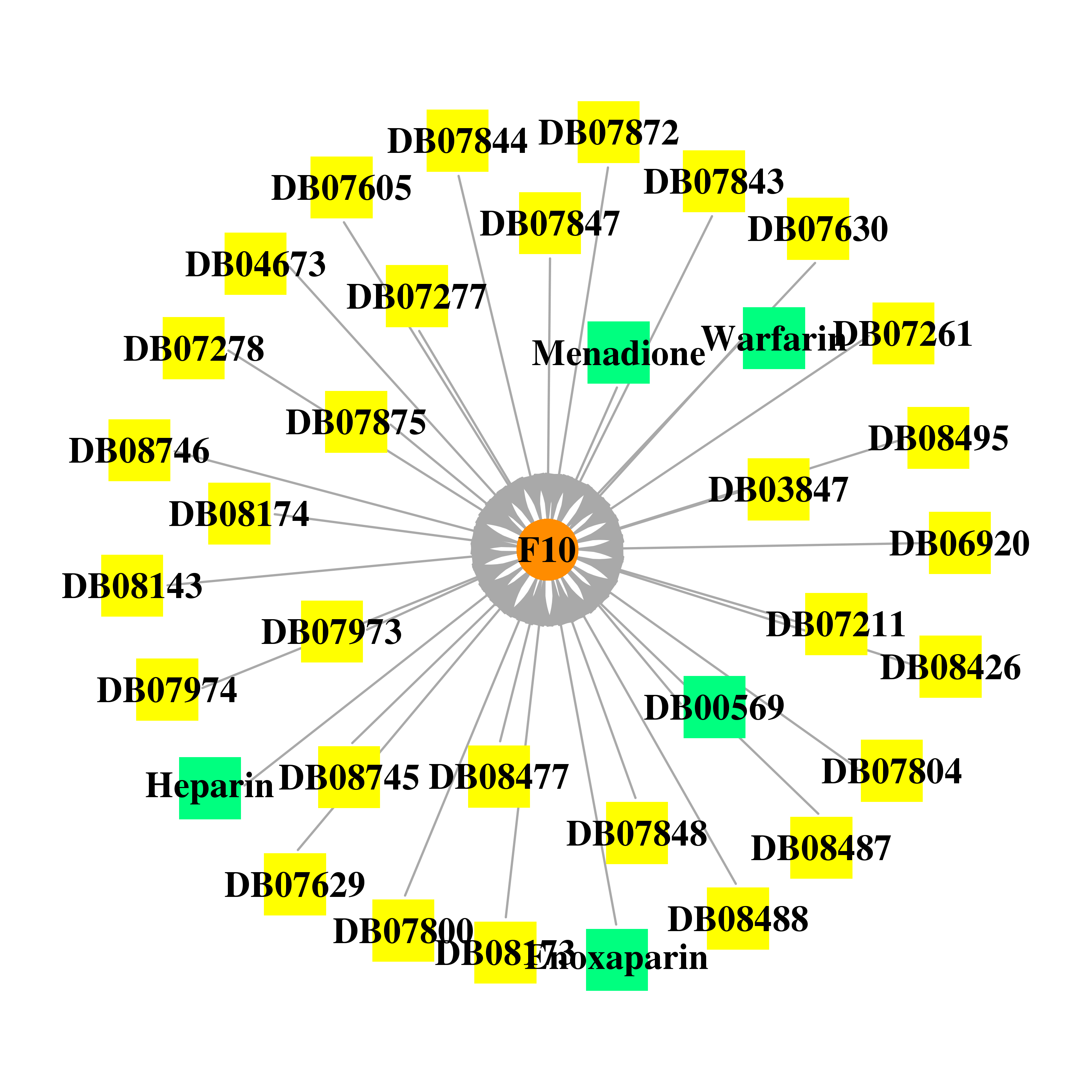 |
| * Drug Centered Interaction Network. |
| DrugBank ID | Target Name | Drug Groups | Generic Name | Drug Centered Network | Drug Structure |
| DB00170 | coagulation factor X | approved; nutraceutical | Menadione |  |  |
| DB00569 | coagulation factor X | approved; investigational | Fondaparinux sodium | 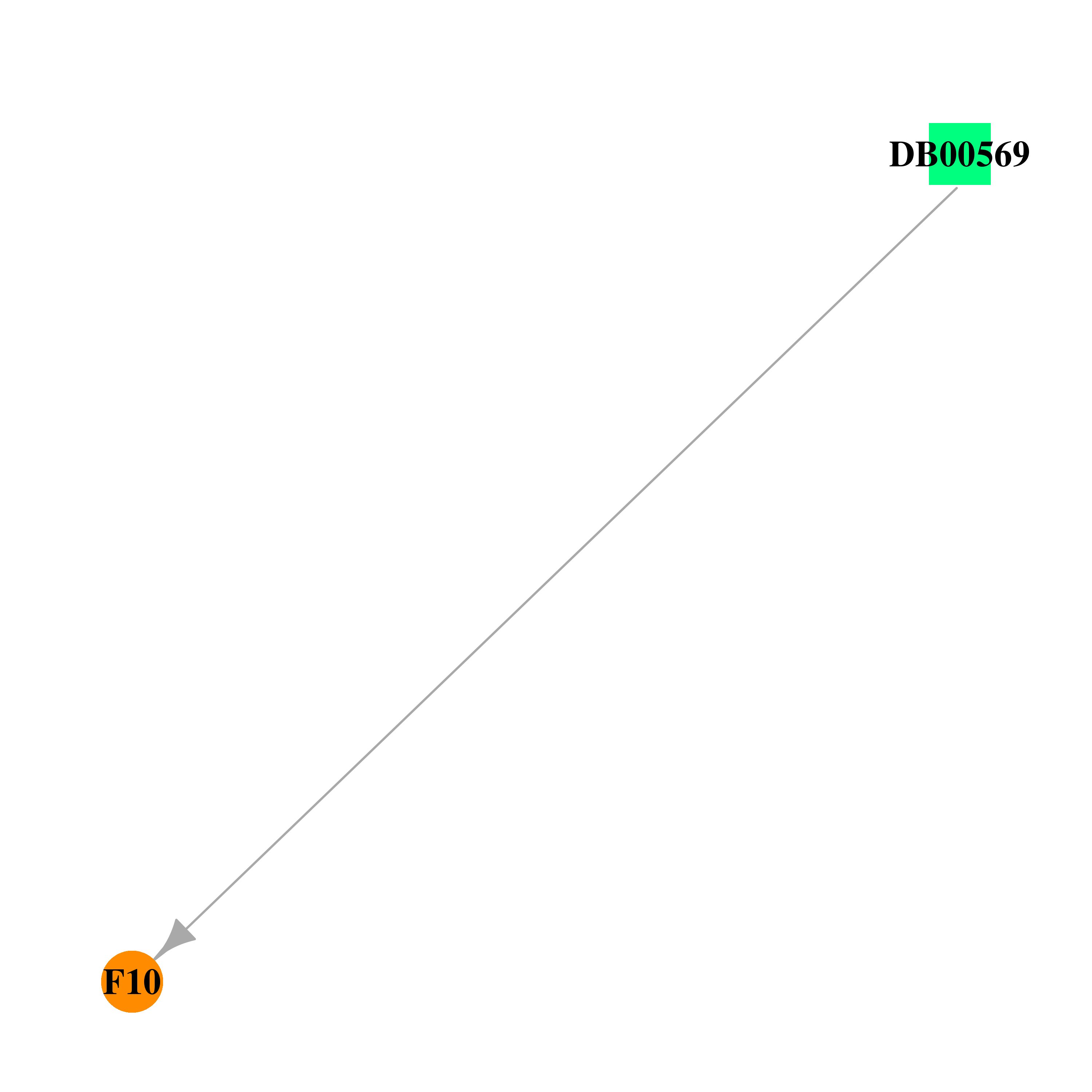 |  |
| DB01109 | coagulation factor X | approved; investigational | Heparin | 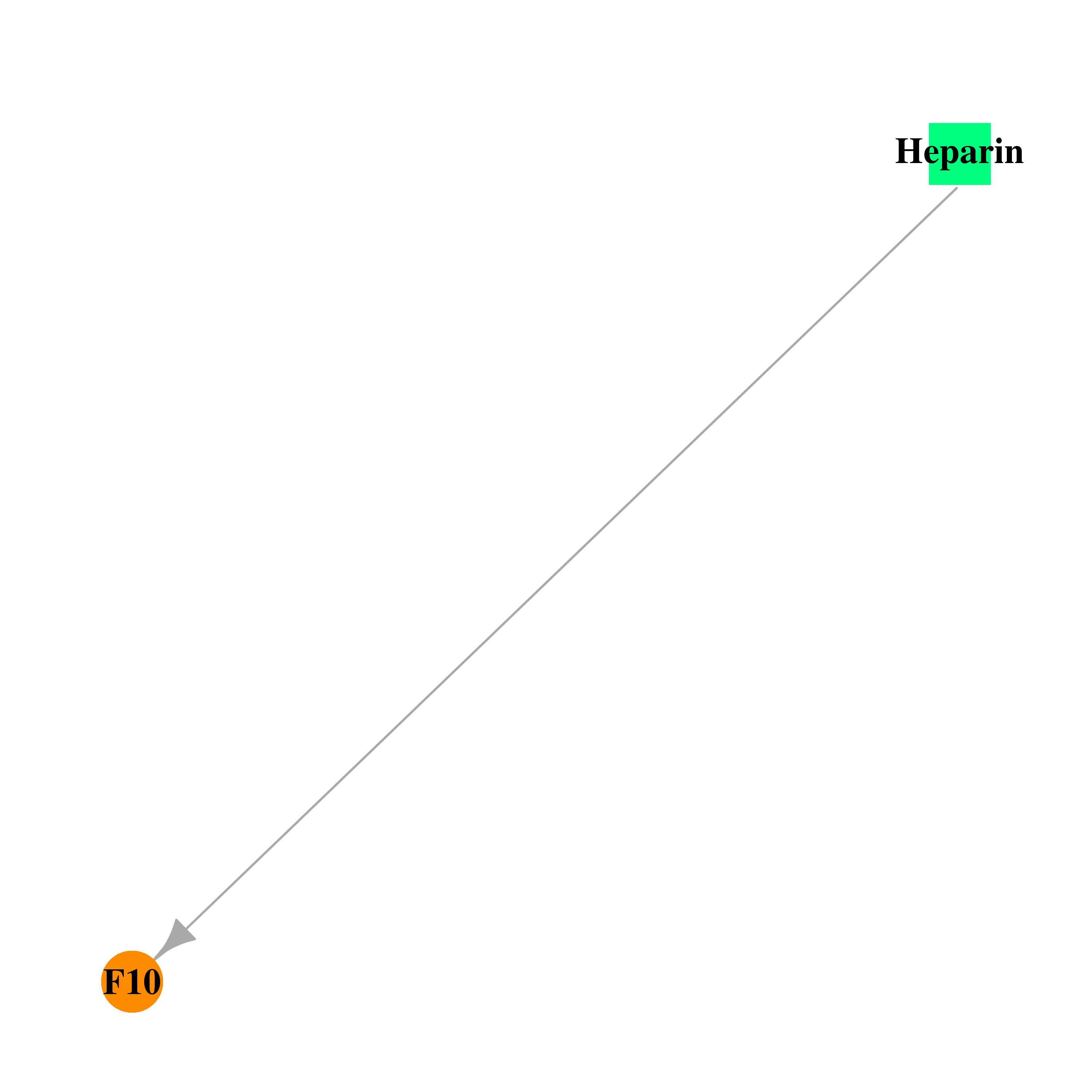 | 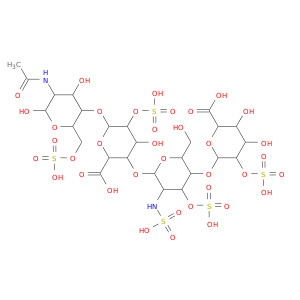 |
| DB01225 | coagulation factor X | approved; investigational | Enoxaparin | 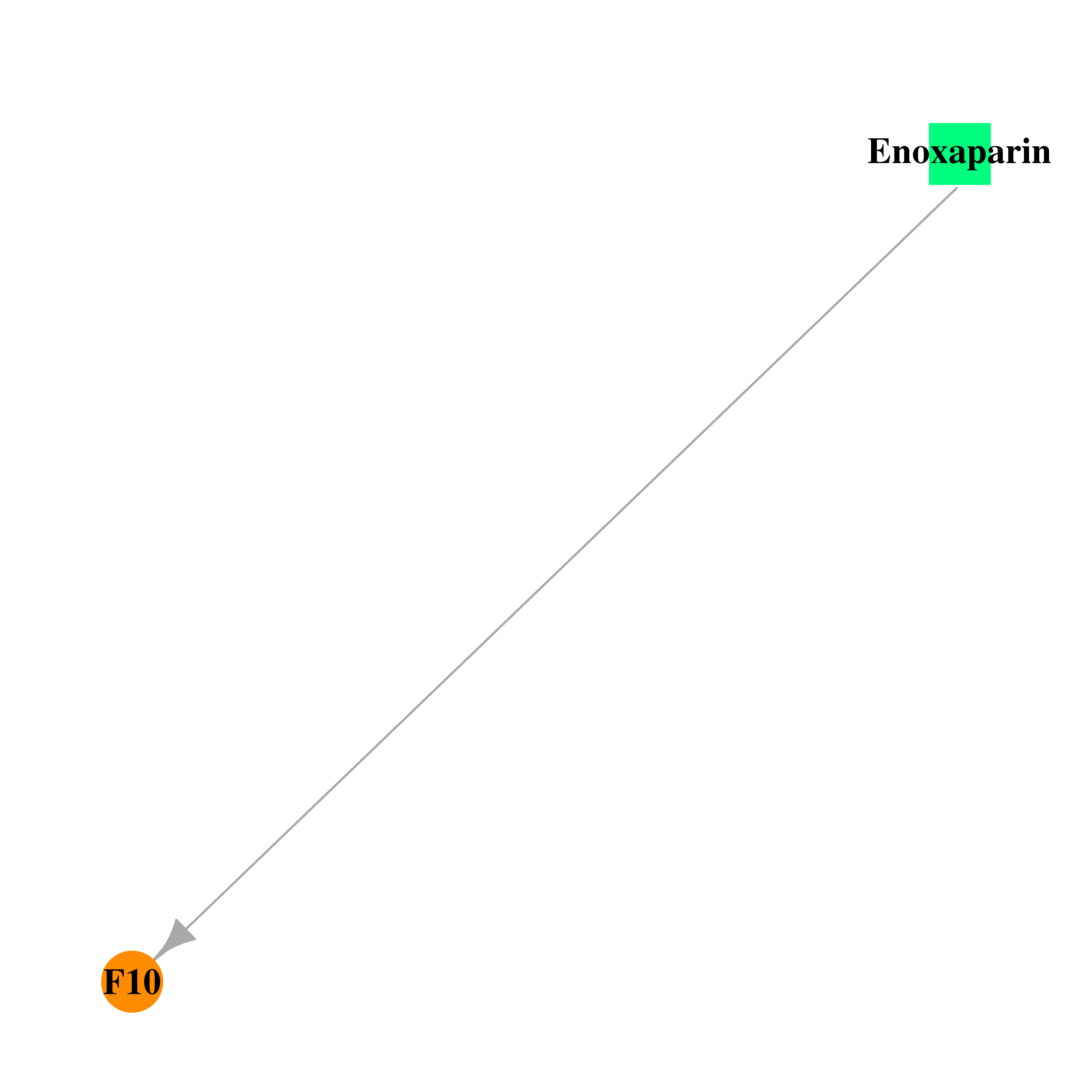 | 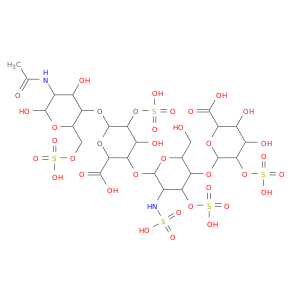 |
| DB03847 | coagulation factor X | experimental | Gamma-Carboxy-Glutamic Acid |  |  |
| DB04673 | coagulation factor X | experimental | 4-[(5-CHLOROINDOL-2-YL)SULFONYL]-2-(2-METHYLPROPYL)-1-[[5-(PYRIDIN-4-YL)PYRIMIDIN-2-YL]CARBONYL]PIPERAZINE |  |  |
| DB06920 | coagulation factor X | experimental | (2R,4R)-N~1~-(4-CHLOROPHENYL)-N~2~-[2-FLUORO-4-(2-OXOPYRIDIN-1(2H)-YL)PHENYL]-4-METHOXYPYRROLIDINE-1,2-DICARBOXAMIDE |  |  |
| DB07211 | coagulation factor X | experimental | (2R)-2-(5-CHLORO-2-THIENYL)-N-{(3S)-1-[(1S)-1-METHYL-2-MORPHOLIN-4-YL-2-OXOETHYL]-2-OXOPYRROLIDIN-3-YL}PROPENE-1-SULFONAMIDE | 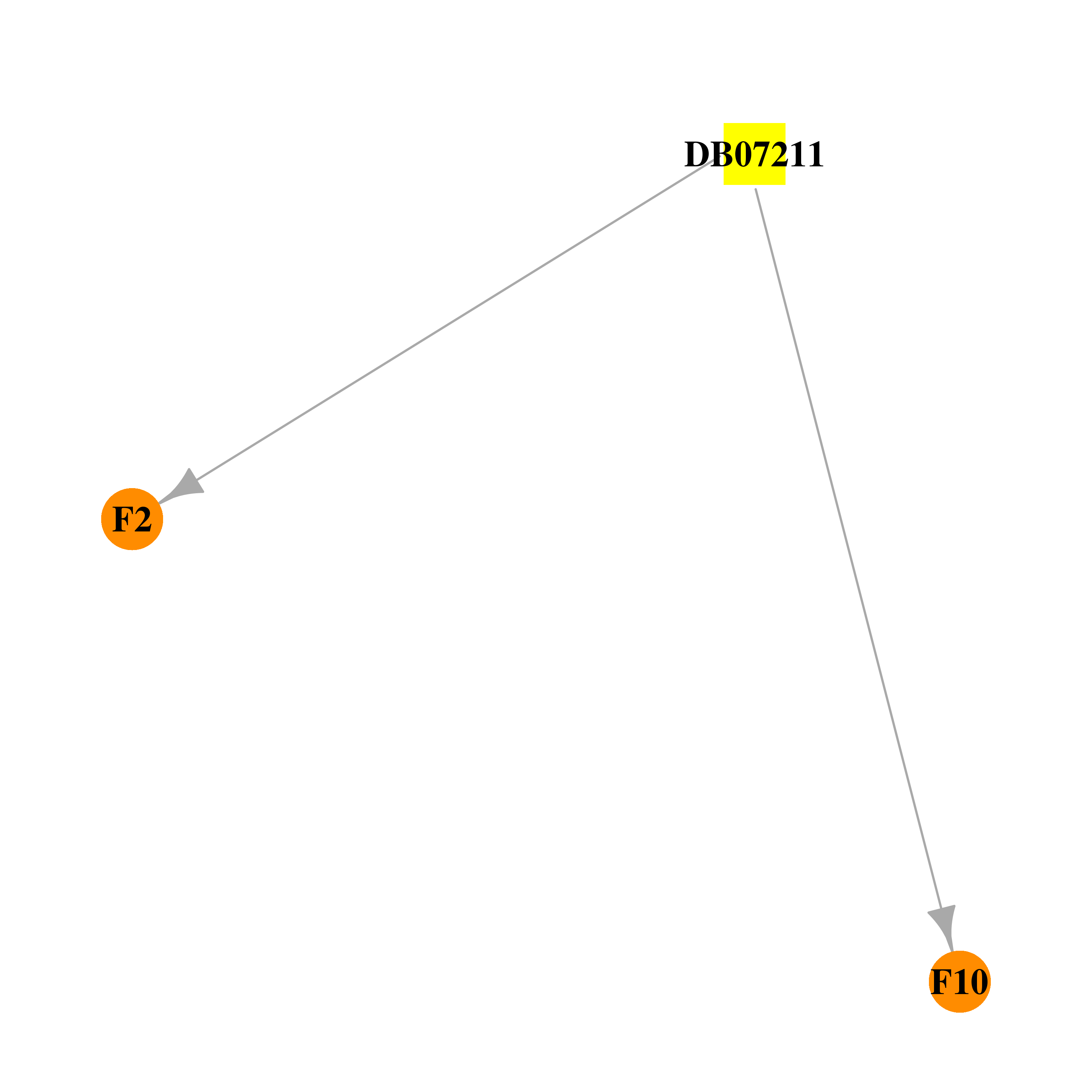 | 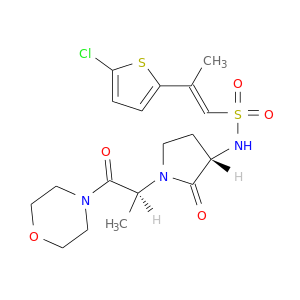 |
| DB07261 | coagulation factor X | experimental | THIENO[3,2-B]PYRIDINE-2-SULFONIC ACID [1-(1-AMINO-ISOQUINOLIN-7-YLMETHYL)-2-OXO-PYRROLDIN-3-YL]-AMIDE | 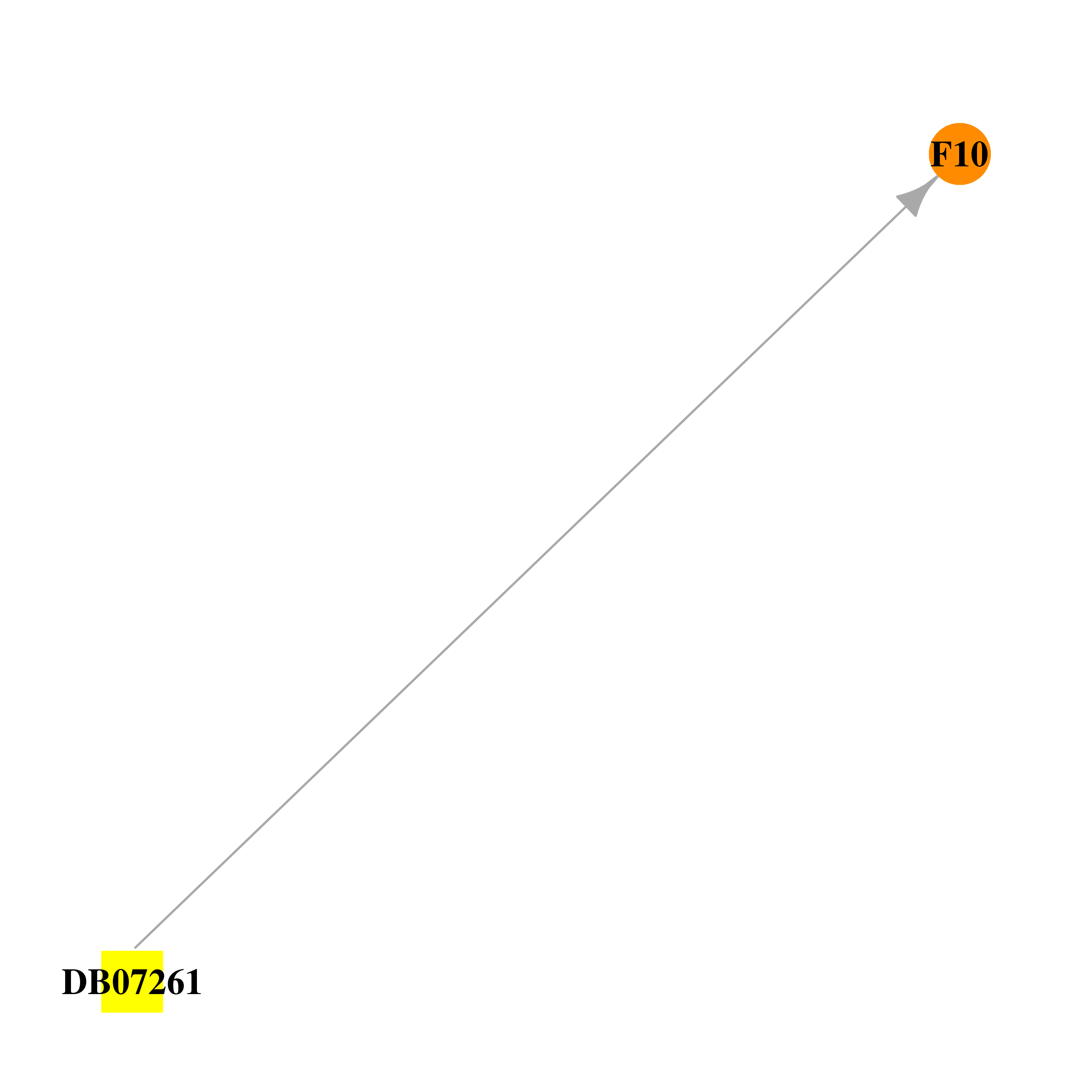 | 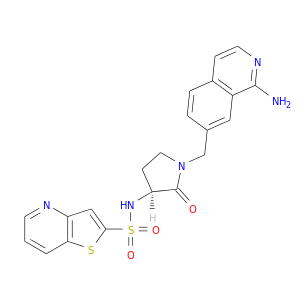 |
| DB07277 | coagulation factor X | experimental | 2-(5-CHLORO-2-THIENYL)-N-{(3S)-1-[(1S)-1-METHYL-2-MORPHOLIN-4-YL-2-OXOETHYL]-2-OXOPYRROLIDIN-3-YL}ETHANESULFONAMIDE | 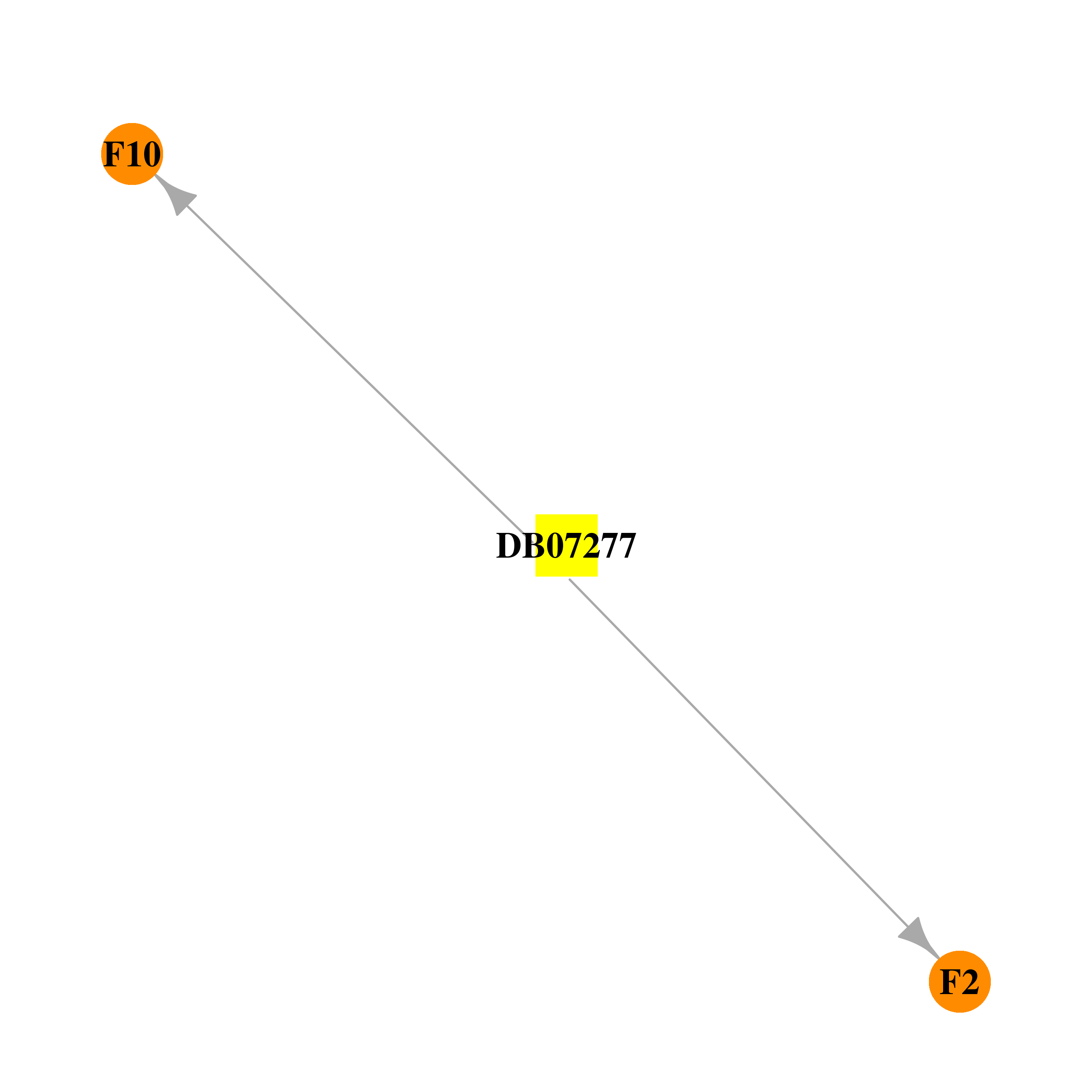 | 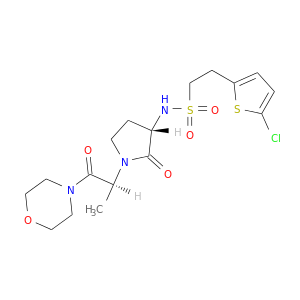 |
| DB07278 | coagulation factor X | experimental | 2-(5-CHLORO-2-THIENYL)-N-{(3S)-1-[(1S)-1-METHYL-2-MORPHOLIN-4-YL-2-OXOETHYL]-2-OXOPYRROLIDIN-3-YL}ETHENESULFONAMIDE | 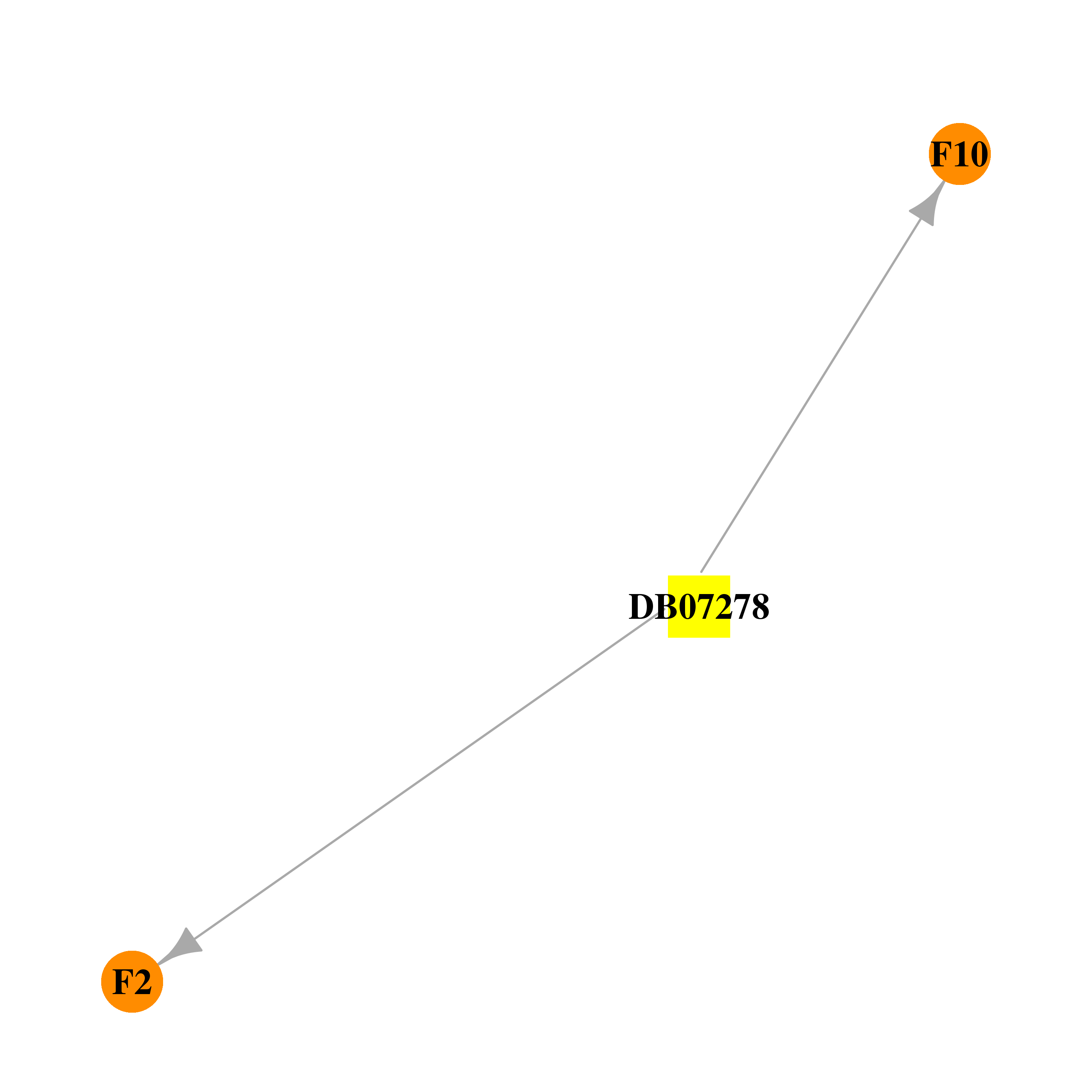 | 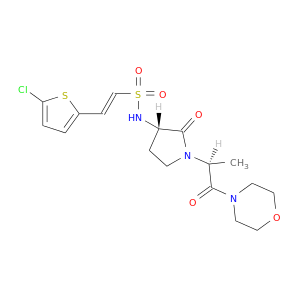 |
| DB07605 | coagulation factor X | experimental | 2-({4-[(5-CHLORO-1H-INDOL-2-YL)SULFONYL]PIPERAZIN-1-YL}CARBONYL)THIENO[3,2-B]PYRIDINE 4-OXIDE |  | 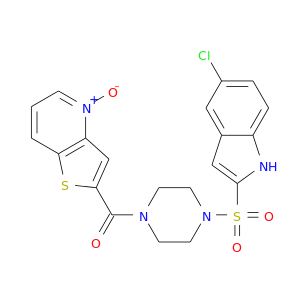 |
| DB07629 | coagulation factor X | experimental | N-((1R,2S)-2-(5-CHLORO-1H-INDOLE-2-CARBOXAMIDO)CYCLOHEXYL)-5-METHYL-4,5,6,7-TETRAHYDROTHIAZOLO[5,4-C]PYRIDINE-2-CARBOXAMIDE | 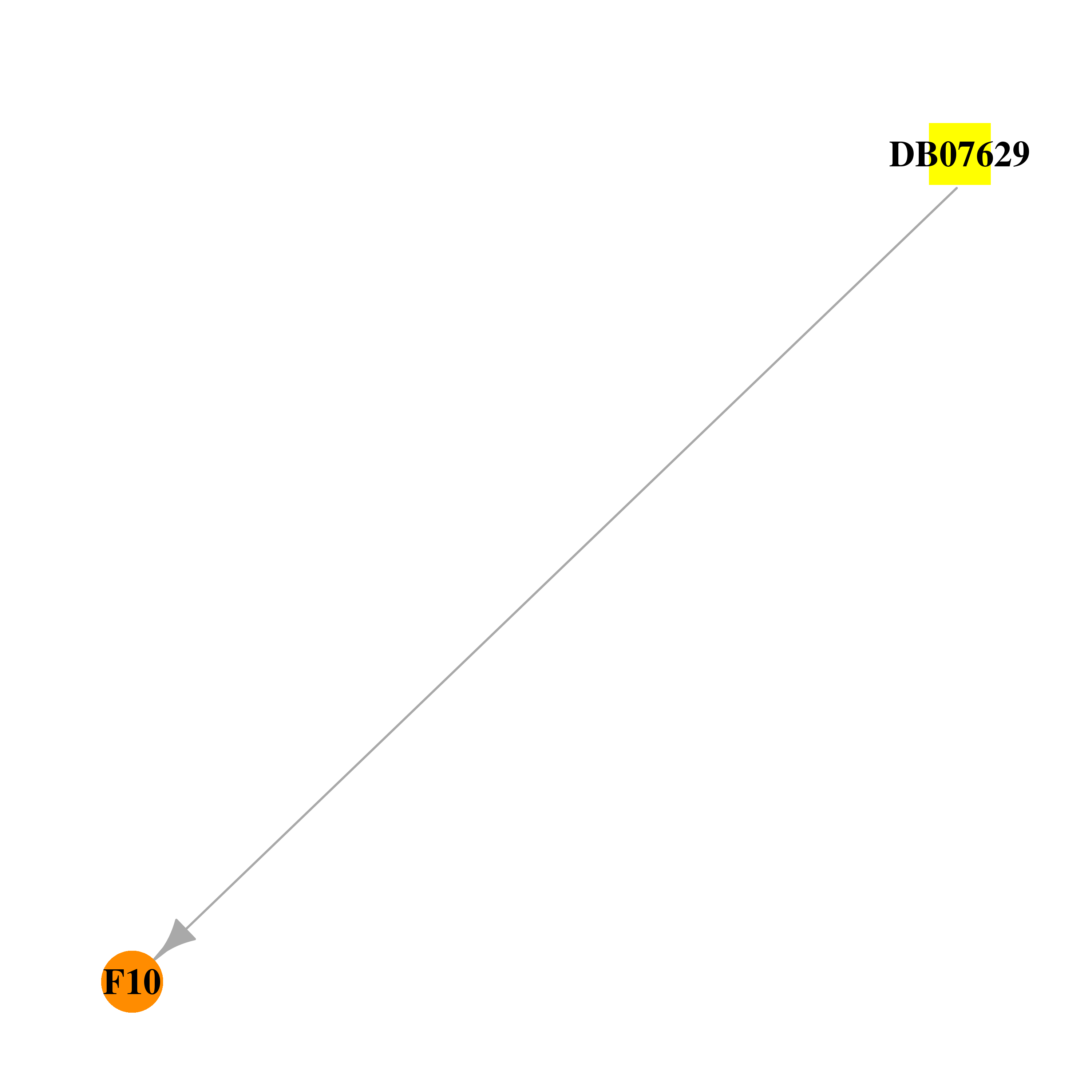 |  |
| DB07630 | coagulation factor X | experimental | N-((1R,2R)-2-(5-CHLORO-1H-INDOLE-2-CARBOXAMIDO)CYCLOHEXYL)-5-METHYL-4,5,6,7-TETRAHYDROTHIAZOLO[5,4-C]PYRIDINE-2-CARBOXAMIDE |  | 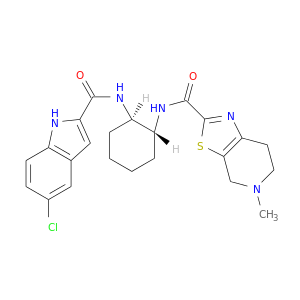 |
| DB07800 | coagulation factor X | experimental | N-(2-(((5-CHLORO-2-PYRIDINYL)AMINO)SULFONYL)PHENYL)-4-(2-OXO-1(2H)-PYRIDINYL)BENZAMIDE |  | 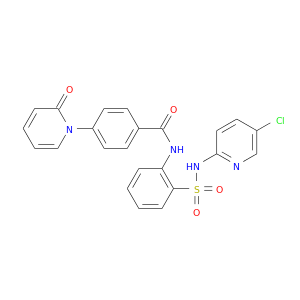 |
| DB07804 | coagulation factor X | experimental | 5-(5-CHLORO-2-THIENYL)-N-{(3S)-1-[(1S)-1-METHYL-2-MORPHOLIN-4-YL-2-OXOETHYL]-2-OXOPYRROLIDIN-3-YL}-1H-1,2,4-TRIAZOLE-3-SULFONAMIDE |  |  |
| DB07843 | coagulation factor X | experimental | 5-CHLORO-N-{(3S)-1-[(1S)-1-METHYL-2-MORPHOLIN-4-YL-2-OXOETHYL]-2-OXOPYRROLIDIN-3-YL}-1-BENZOTHIOPHENE-2-SULFONAMIDE |  |  |
| DB07844 | coagulation factor X | experimental | 6-CHLORO-N-{(3S)-1-[(1S)-1-METHYL-2-MORPHOLIN-4-YL-2-OXOETHYL]-2-OXOPYRROLIDIN-3-YL}-1-BENZOTHIOPHENE-2-SULFONAMIDE | 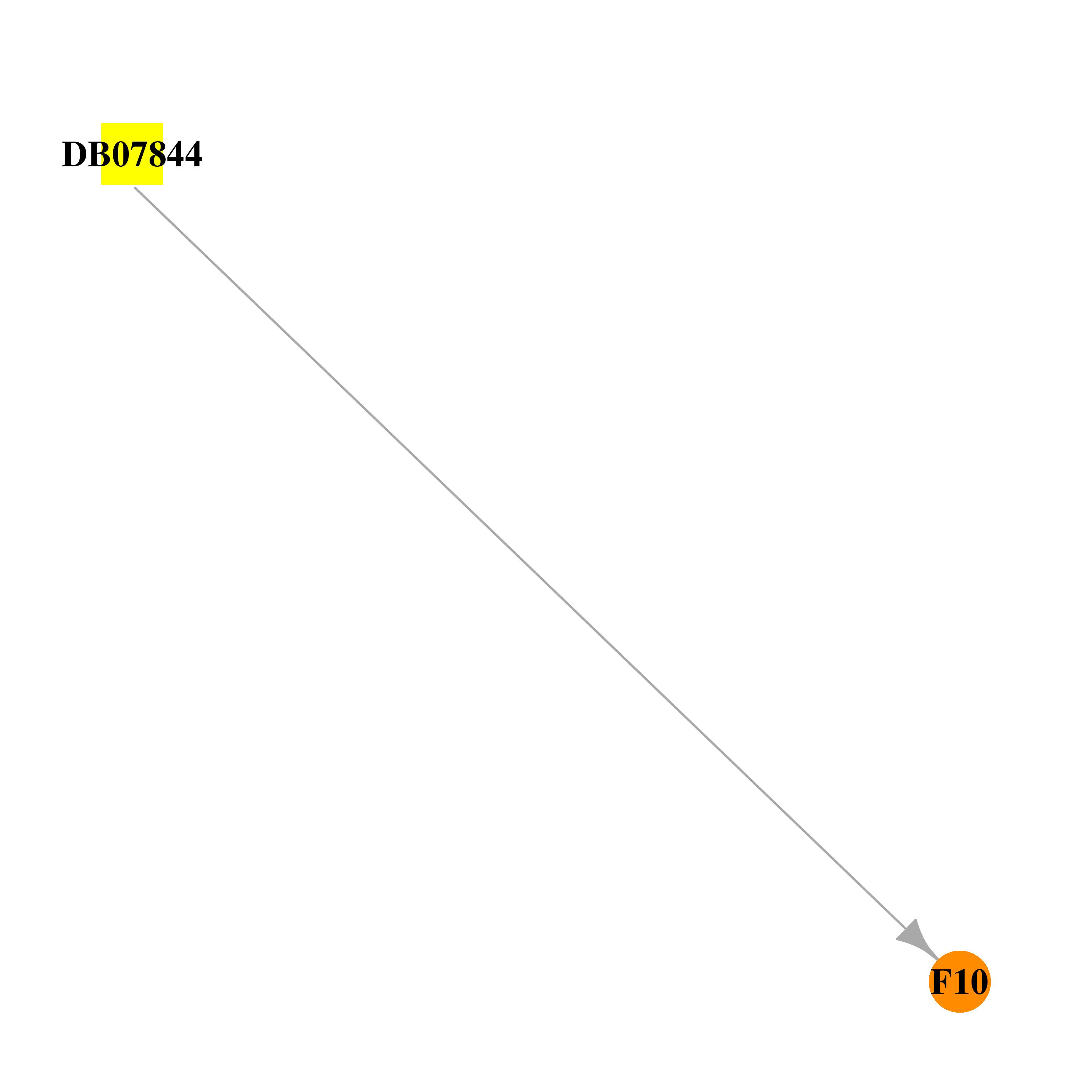 |  |
| DB07847 | coagulation factor X | experimental | 6-CHLORO-N-{(3S)-1-[(1S)-1-METHYL-2-(4-MORPHOLINYL)-2-OXO ETHYL]-2-OXO-3-PYRROLIDINYL}-2-NAPHTHALENESULFONAMIDE | 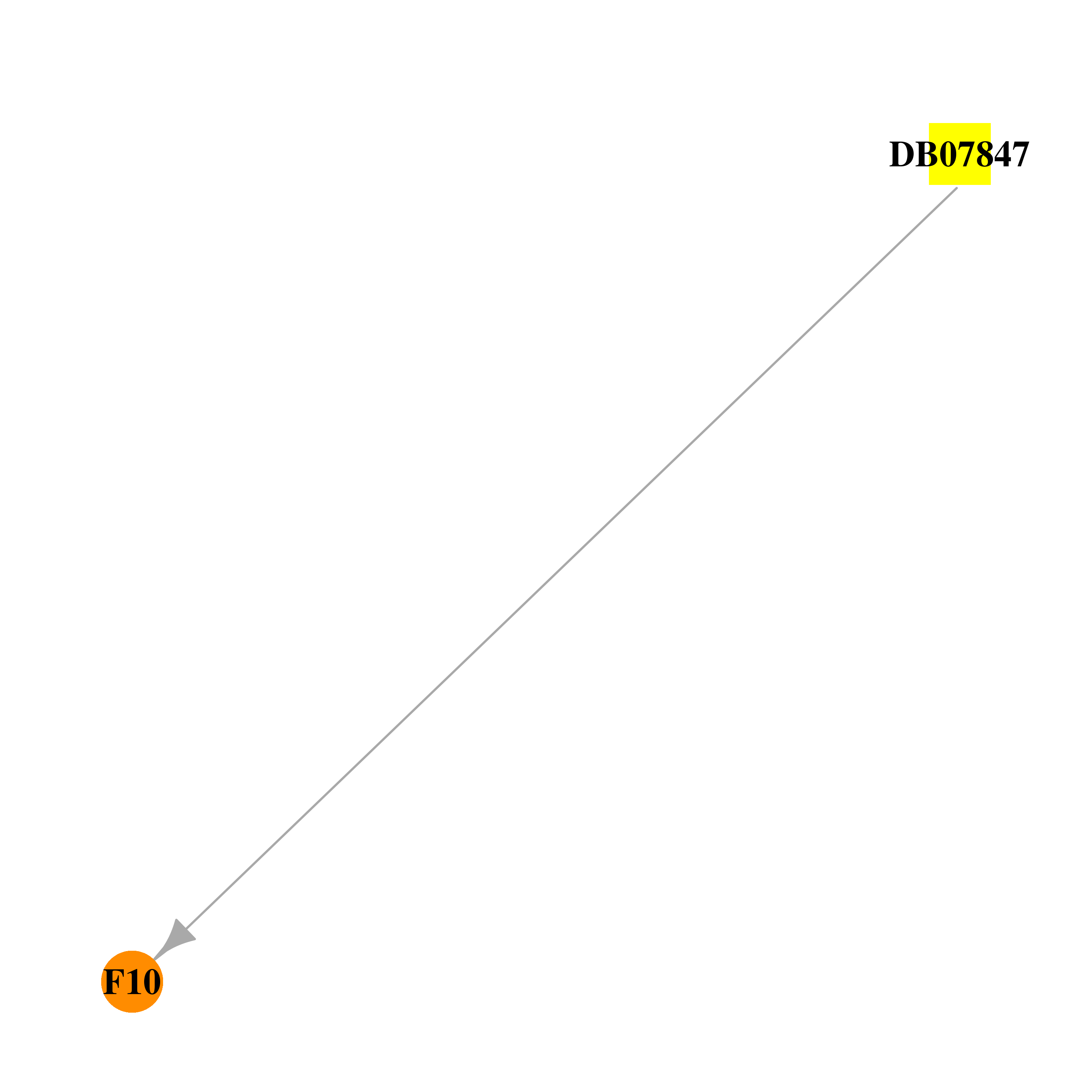 |  |
| DB07848 | coagulation factor X | experimental | 5-CHLORO-N-{(3S)-1-[(1S)-1-METHYL-2-MORPHOLIN-4-YL-2-5-CHLORO-N-{(3S)-1-[(1S)-1-METHYL-2-MORPHOLIN-4-YL-2-SULFONAMIDE | 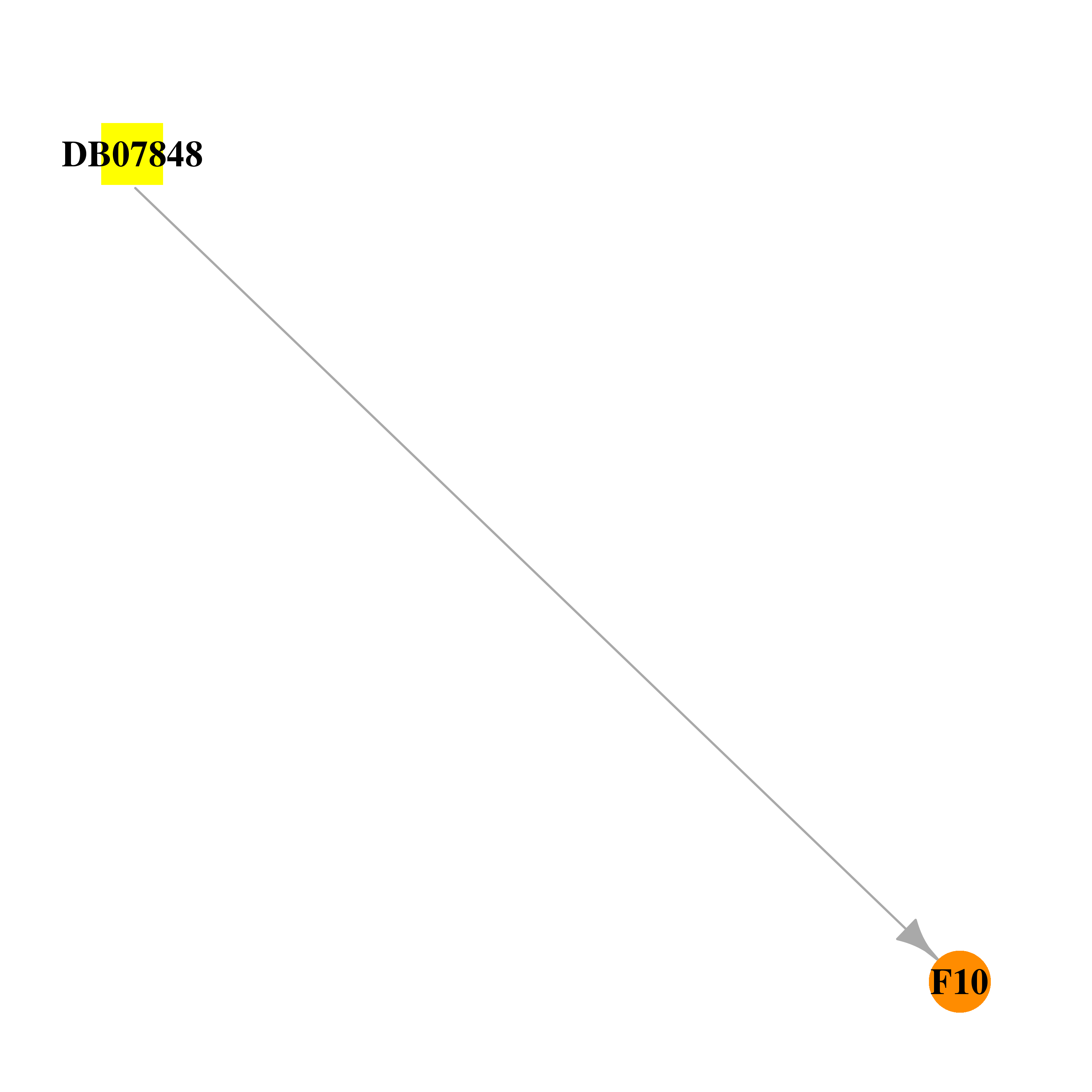 |  |
| DB07872 | coagulation factor X | experimental | 5-chloro-N-[(3R)-1-(2-{[2-fluoro-4-(2-oxopyridin-1(2H)-yl)phenyl]amino}-2-oxoethyl)pyrrolidin-3-yl]thiophene-2-carboxamide | 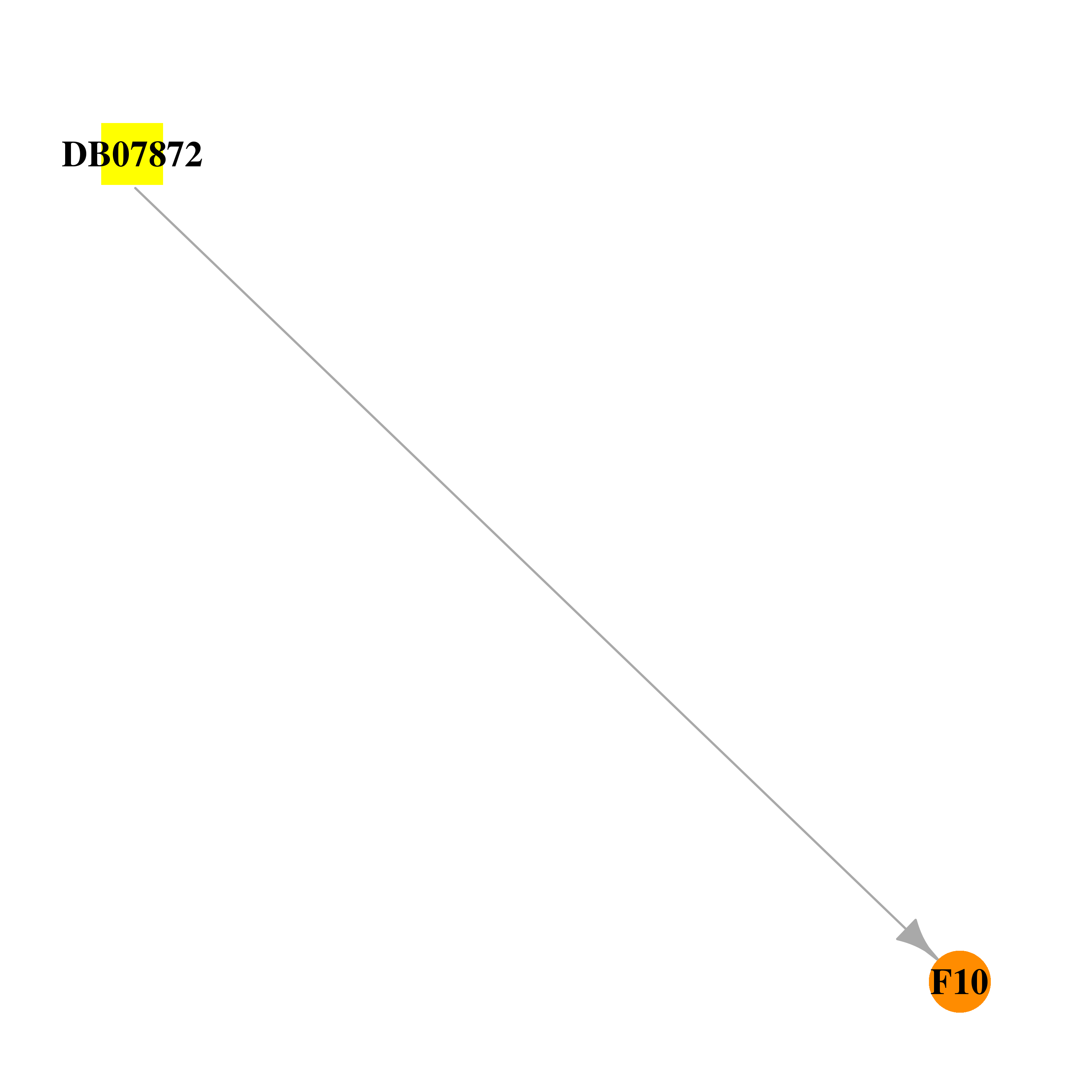 | 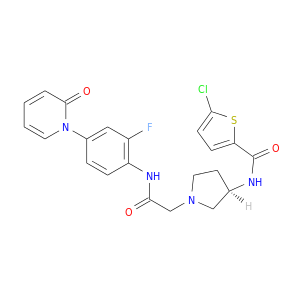 |
| DB07875 | coagulation factor X | experimental | 5-Chloro-thiophene-2-carboxylic acid ((3S,4S)-1-{[2-fluoro-4-(2-oxo-2H-pyridin-1-yl)-phenylcarbamoyl]-methyl}-4-hydroxy-pyrrolidin-3-yl)-amide | 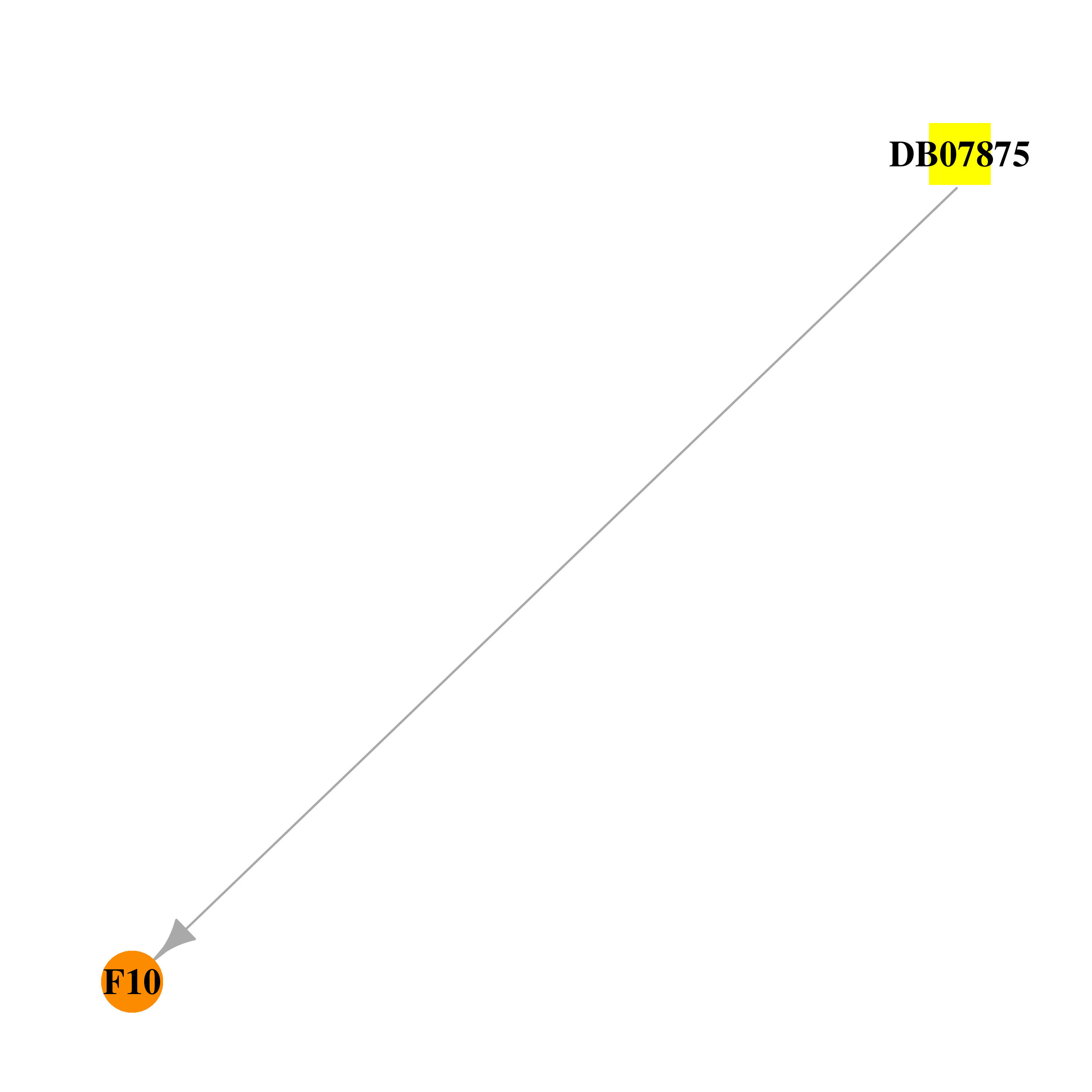 |  |
| DB07973 | coagulation factor X | experimental | N-(1-ISOPROPYLPIPERIDIN-4-YL)-1-(3-METHOXYBENZYL)-1H-INDOLE-2-CARBOXAMIDE | 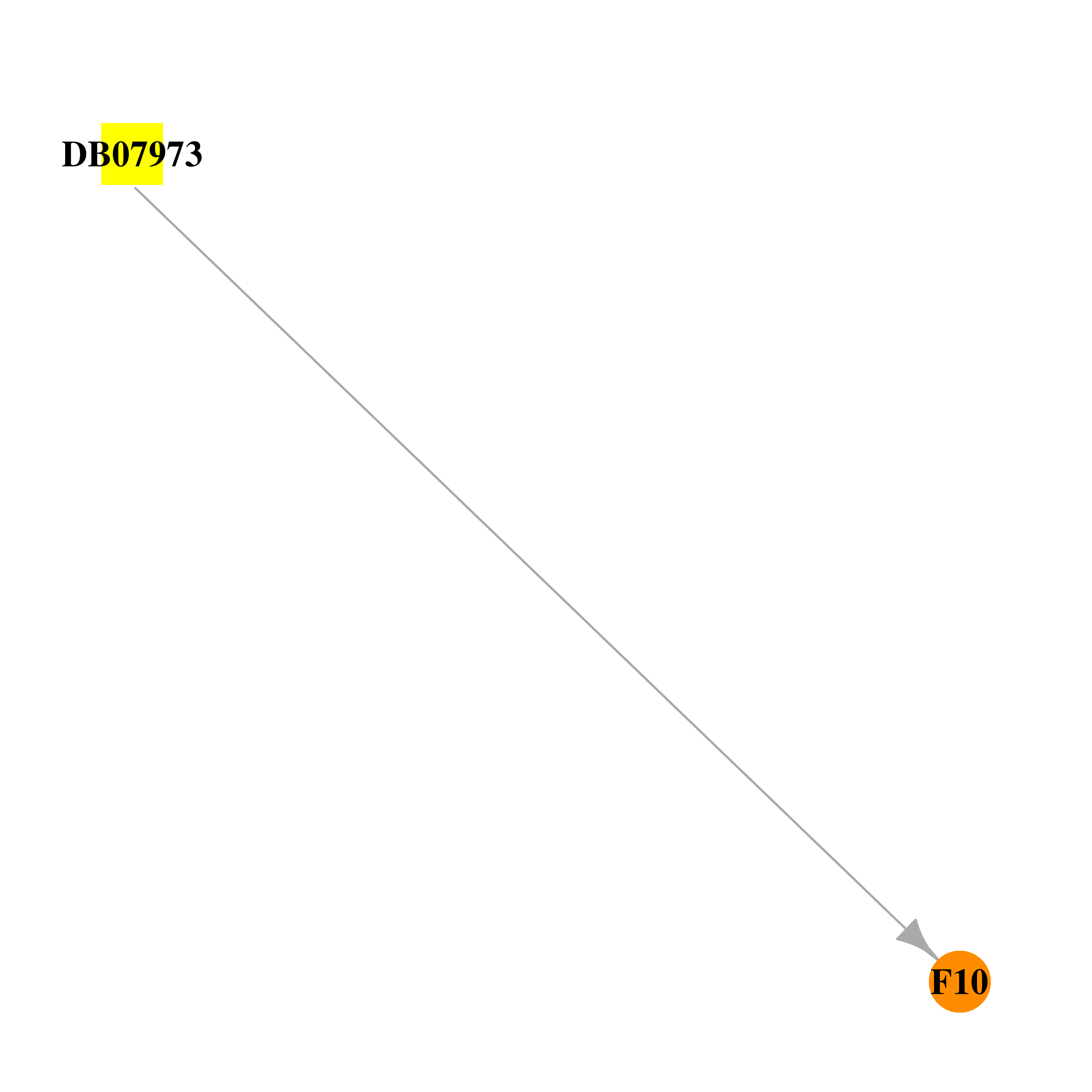 | 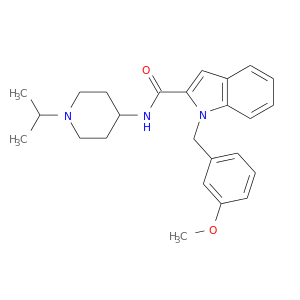 |
| DB07974 | coagulation factor X | experimental | 1-{2-[(4-CHLOROPHENYL)AMINO]-2-OXOETHYL}-N-(1-ISOPROPYLPIPERIDIN-4-YL)-1H-INDOLE-2-CARBOXAMIDE |  | 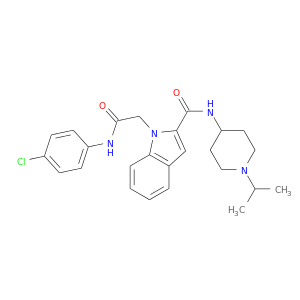 |
| DB08143 | coagulation factor X | experimental | 5-CHLORO-THIOPHENE-2-CARBOXYLIC ACID ((3S,4S)-4-FLUORO- 1-{[2-FLUORO-4-(2-OXO-2H-PYRIDIN-1-YL)-PHENYLCARBAMOYL]-METHYL}-PYRROLIDIN-3-YL)-AMIDE |  | 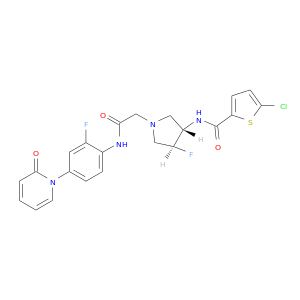 |
| DB08173 | coagulation factor X | experimental | 5-CHLORO-N-(2-(4-(2-OXOPYRIDIN-1(2H)-YL)BENZAMIDO)ETHYL)THIOPHENE-2-CARBOXAMIDE | 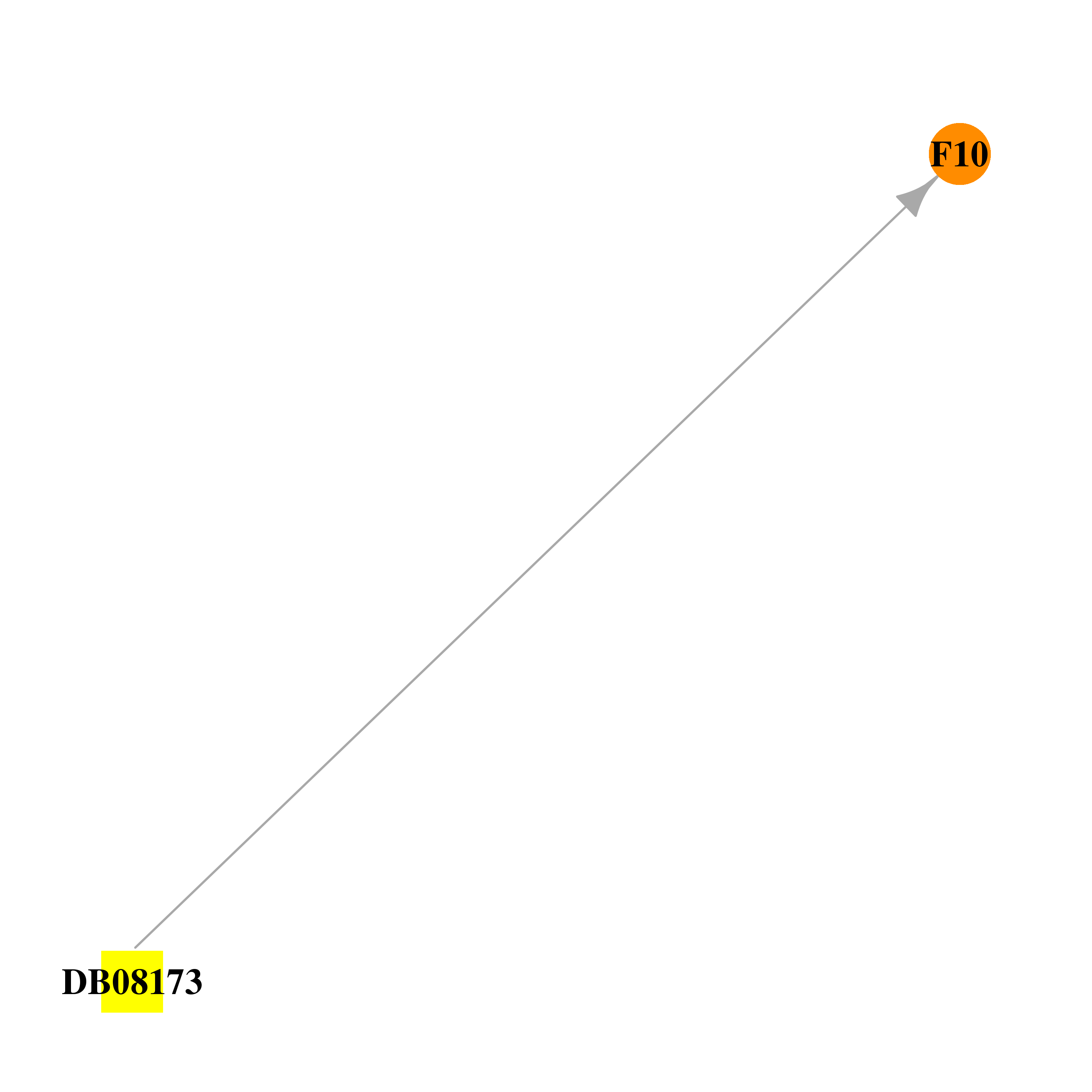 |  |
| DB08174 | coagulation factor X | experimental | 5-CHLORO-N-((1R,2S)-2-(4-(2-OXOPYRIDIN-1(2H)-YL)BENZAMIDO) CYCLOPENTYL)THIOPHENE-2-CARBOXAMIDE |  | 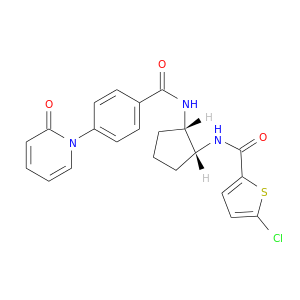 |
| DB08426 | coagulation factor X | experimental | THIENO[3,2-B]PYRIDINE-2-SULFONIC ACID [2-OXO-1-(1H-PYRROLO[2,3-C]PYRIDIN-2-YLMETHYL)-PYRROLIDIN-3-YL]-AMIDE | 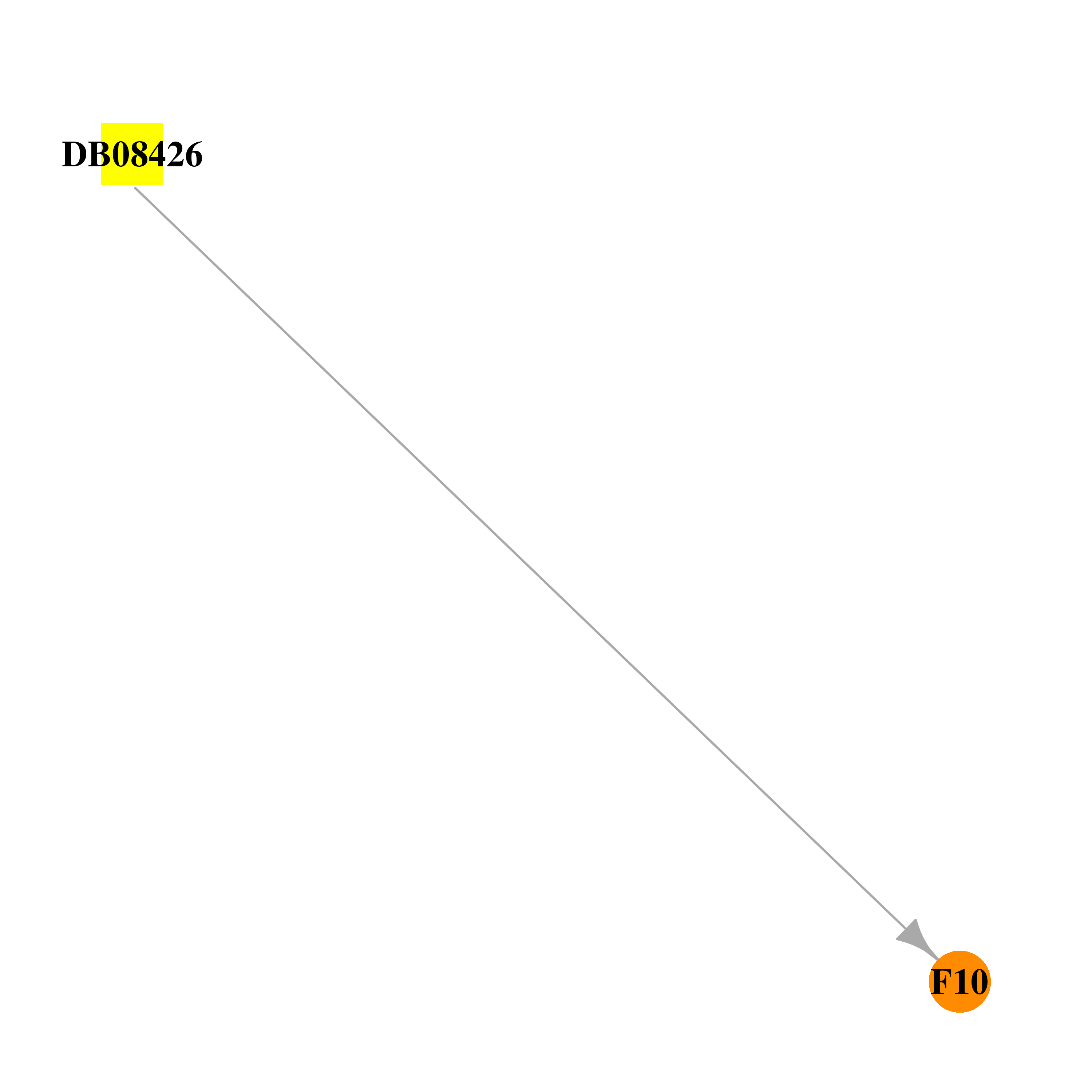 |  |
| DB08477 | coagulation factor X | experimental | 5-chloro-N-({(5S)-2-oxo-3-[4-(3-oxomorpholin-4-yl)phenyl]-1,3-oxazolidin-5-yl}methyl)thiophene-2-carboxamide | 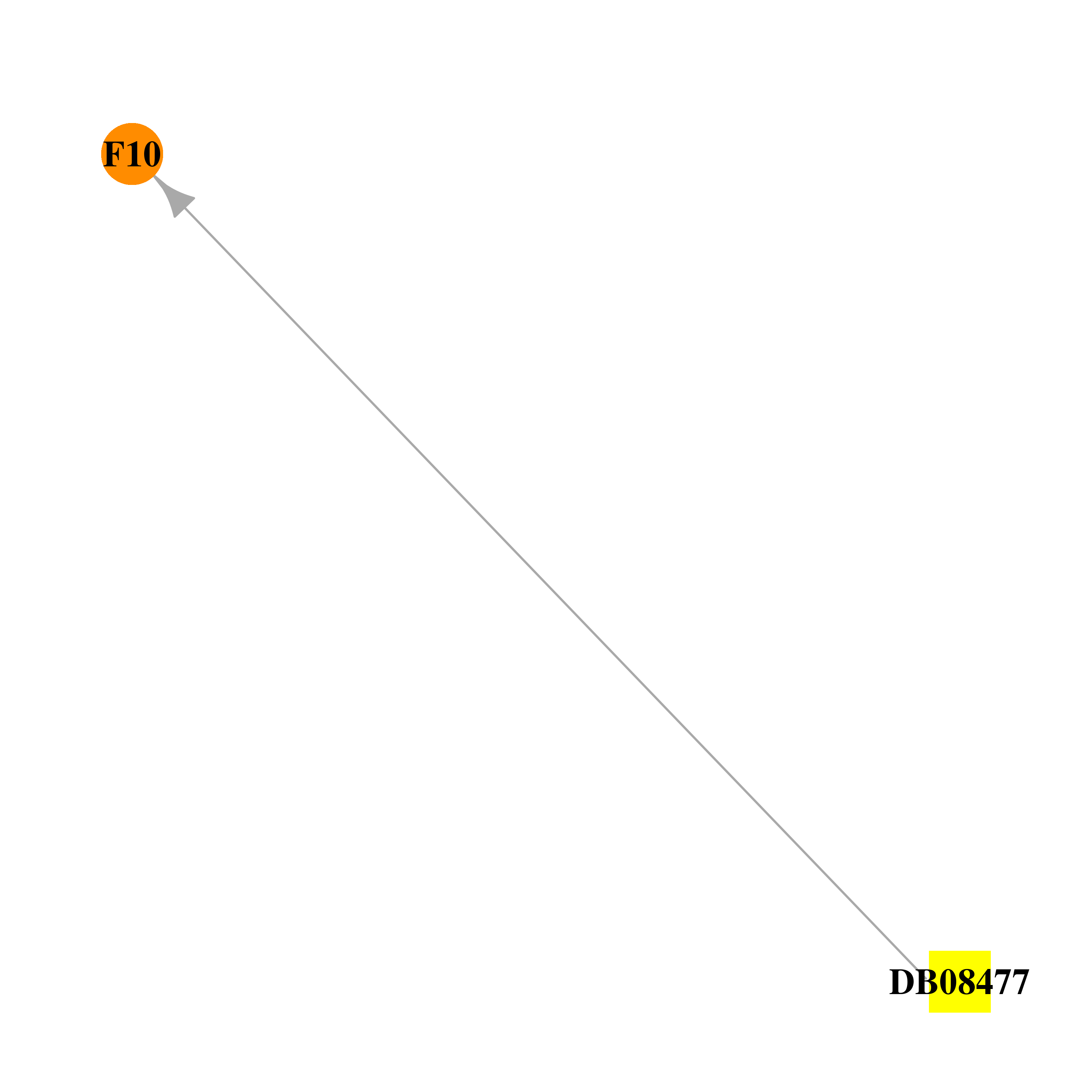 |  |
| DB08487 | coagulation factor X | experimental | 3-({4-[(6-CHLORO-1-BENZOTHIEN-2-YL)SULFONYL]-2-OXOPIPERAZIN-1-YL}METHYL)BENZENECARBOXIMIDAMIDE | 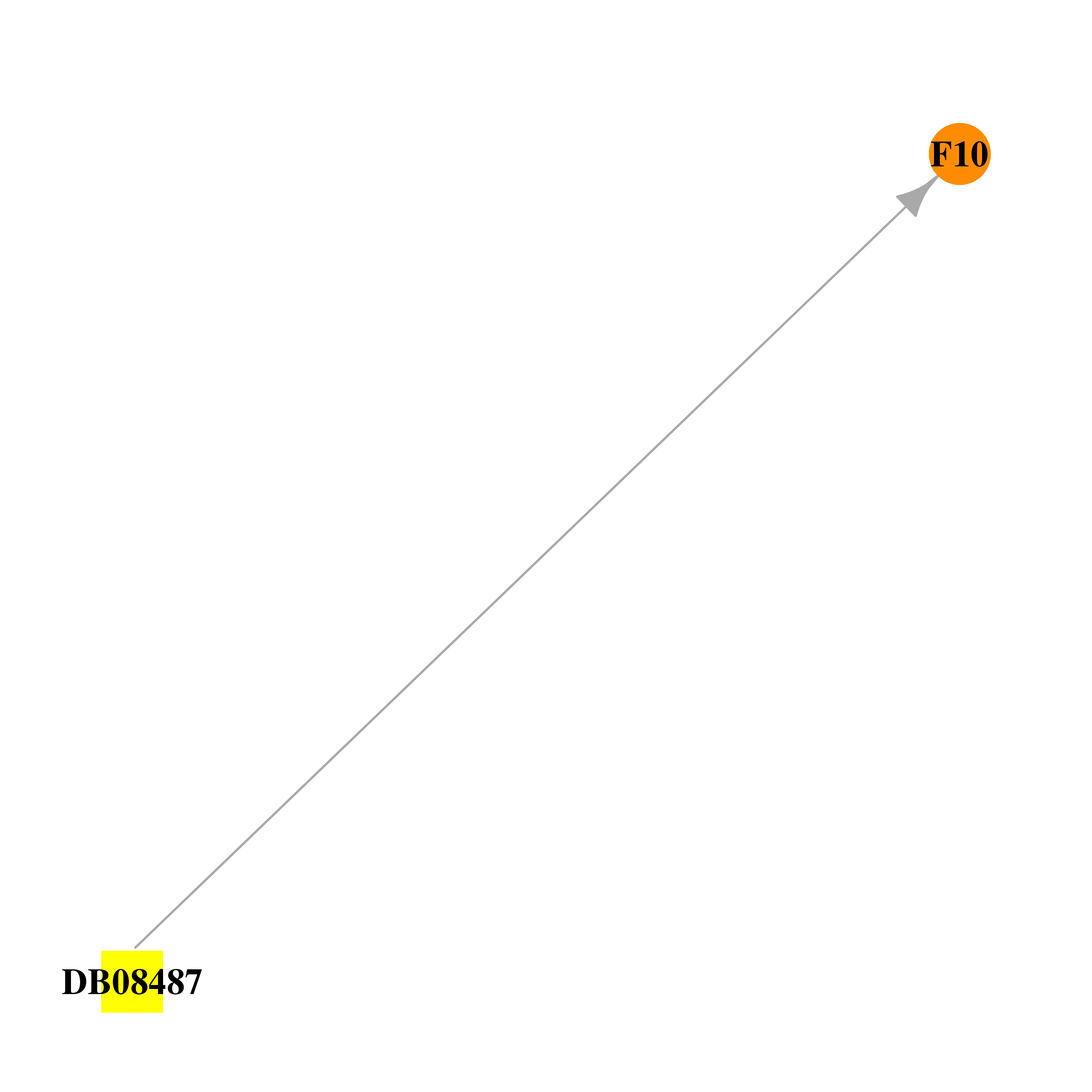 | 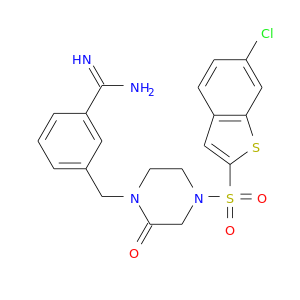 |
| DB08488 | coagulation factor X | experimental | 4-{[(E)-2-(5-CHLOROTHIEN-2-YL)VINYL]SULFONYL}-1-(1H-PYRROLO[3,2-C]PYRIDIN-2-YLMETHYL)PIPERAZIN-2-ONE |  |  |
| DB08495 | coagulation factor X | experimental | 4-({4-[(6-CHLORO-1-BENZOTHIEN-2-YL)SULFONYL]-2-OXOPIPERAZIN-1-YL}METHYL)BENZENECARBOXIMIDAMIDE |  |  |
| DB08745 | coagulation factor X | experimental | 4-[[(1E)-2-(4-CHLOROPHENYL)ETHENYL]SULFONYL]-1-[[1-(4-PYRIDINYL)-4-PIPERIDINYL]METHYL]PIPERAZINONE | 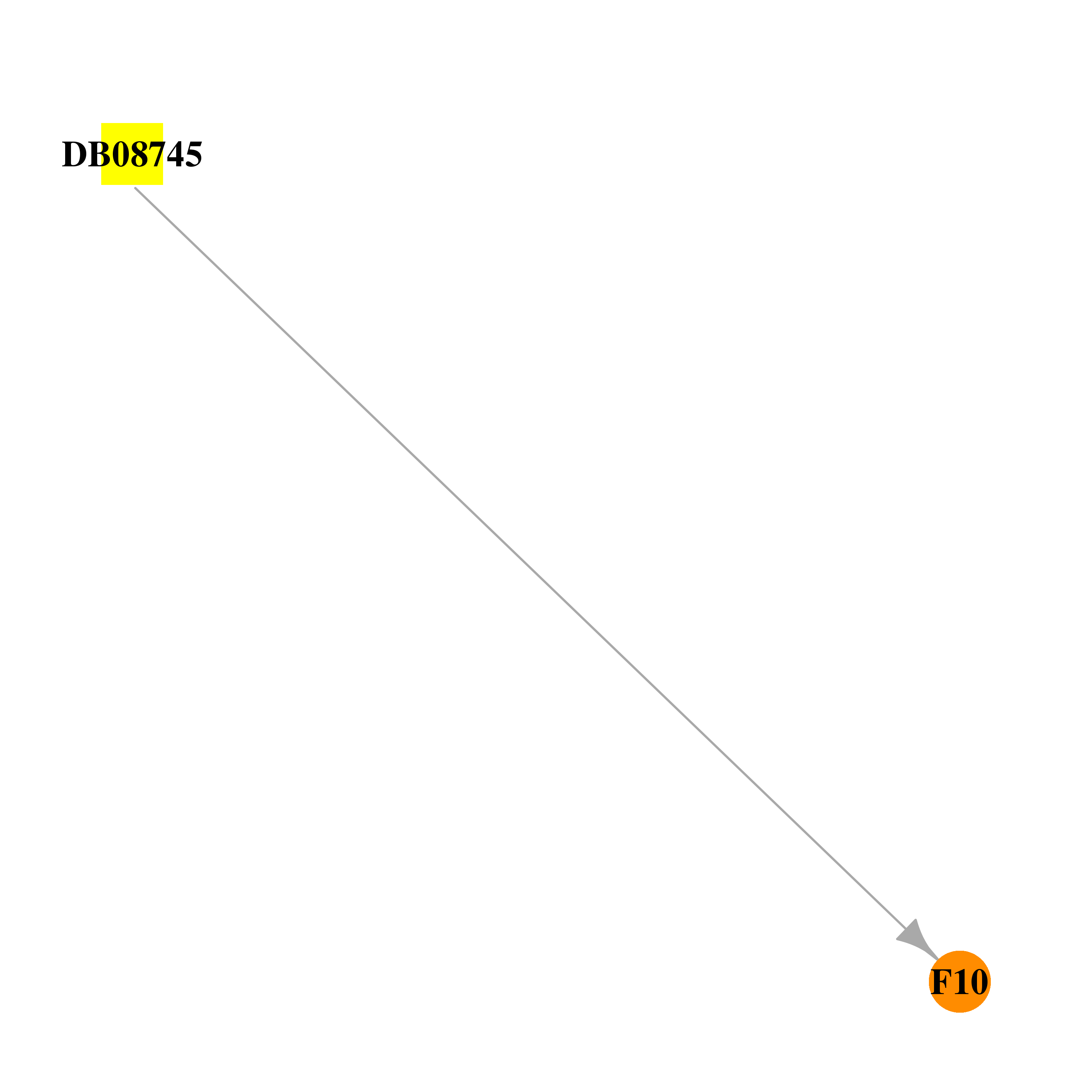 | 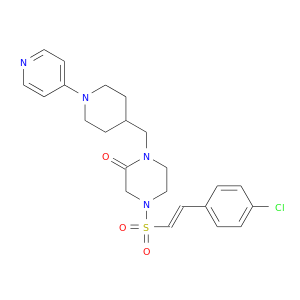 |
| DB08746 | coagulation factor X | experimental | 1-[[(1E)-2-(4-CHLOROPHENYL)ETHENYL]SULFONYL]-4-[[1-(4-PYRIDINYL)-4-PIPERIDINYL]METHYL]PIPERAZINE |  | 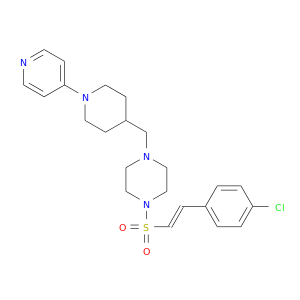 |
| DB00682 | coagulation factor X | approved | Warfarin |  | 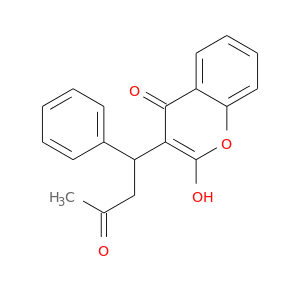 |
| Top |
| Cross referenced IDs for F10 |
| * We obtained these cross-references from Uniprot database. It covers 150 different DBs, 18 categories. http://www.uniprot.org/help/cross_references_section |
: Open all cross reference information
|
Copyright © 2016-Present - The Univsersity of Texas Health Science Center at Houston @ |






